Orca tenerife: Loro Parque | Hello Canary Islands
Loro Parque: Orca Conservation or a Show of Submission?
At 11:35 a.m. on a Thursday morning, the orca show at Loro Parque, a zoo in northern Tenerife in the Canary Islands of Spain, is about to begin. Visitors flock to the stadium to watch this first show of the day. I hear voices in several European languages, among them British, German, and Danish, and the stadium soon fills with commotion and chatter as suntanned holidaymakers decide where to sit. Some select seats in the so-called splash zone at the front of the stadium. This is where spectators can experience the thrill of getting drenched as orcas whip up cascades of water from the show pool with their tail flukes. Others choose seats farther up where they get a better view of the performance.
I haven’t been here for five years. The amphitheater, with its ascending rows of plastic chairs placed in a half circle around it, is as bleak and dreary today as it was then. Five orcas perform here twice a day: three males named Keto, Tekoa, and Adan, and two females named Kohana and Morgan. Keto, Tekoa, and Kohana once lived at SeaWorld locations in the United States. SeaWorld sent them to Loro Parque in February of 2006 to help it launch its brand-new tourist attraction. A fourth orca—a young calf named Skyla—was on the cargo plane with Keto, Tekoa, and Kohana, but she died in March 2021.
Kohana, Keto, and Morgan respond to their trainers’ hand signals in one of the holding tanks and, as a reward for their cooperation, receive dead fish from stainless steel buckets. Credit: Helene O’Barry/Dolphin Project
Skyla and Kohana were just two and three years old, respectively, when staff at SeaWorld Orlando separated them from their mothers and sent them on the long journey across the Atlantic Ocean to Tenerife. Tekoa, five years old at the time, and Keto, then ten years old, both came from SeaWorld San Antonio. They were all listed on SeaWorld’s website as part of the entertainment giant’s beloved family of orcas, but in September of 2017, SeaWorld transferred ownership of them to Loro Parque, and SeaWorld no longer refers to them as family.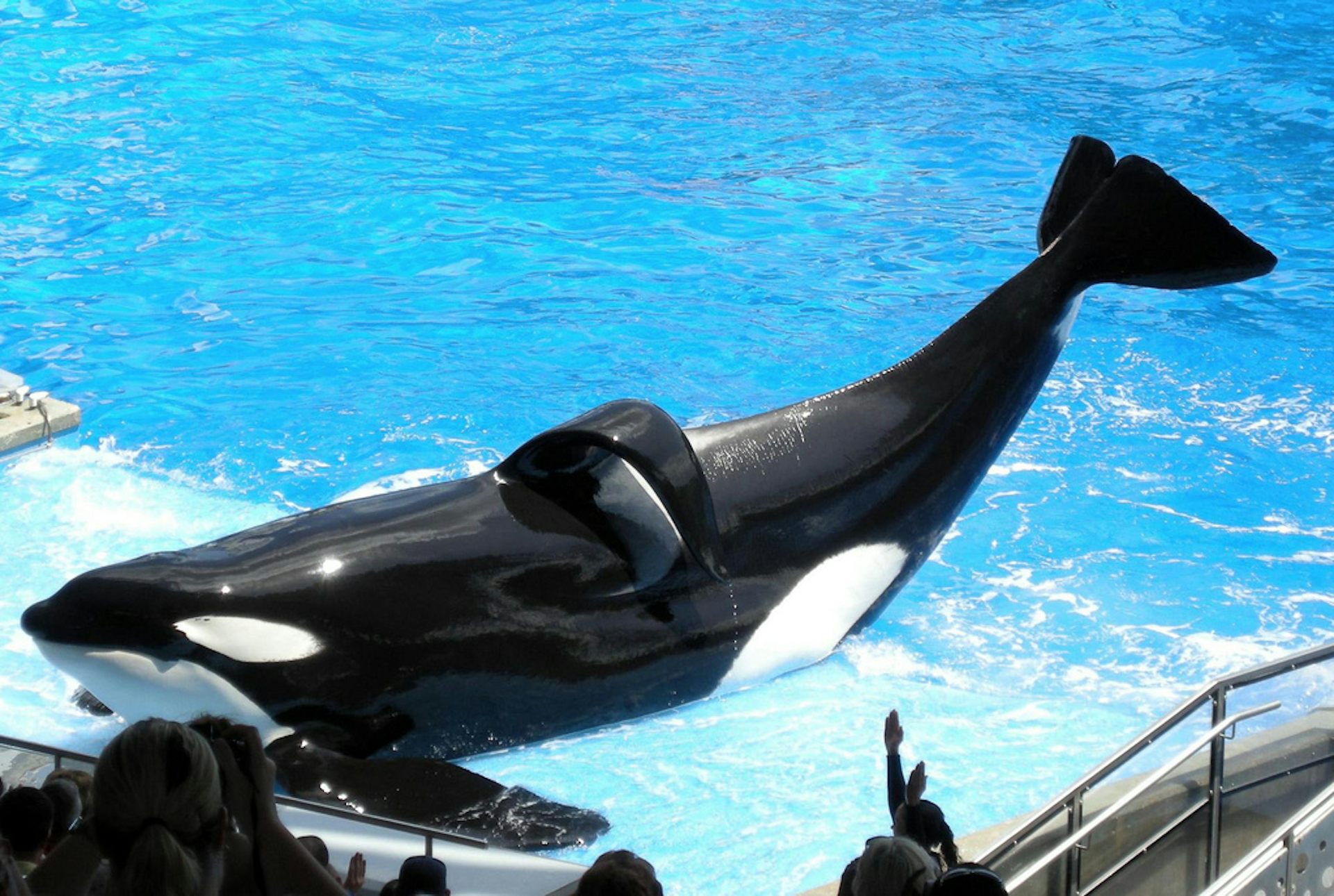
Adan was born at Loro Parque in October 2010. His mother is Kohana. At just eight years old, Kohana was one of the youngest orcas ever to give birth in captivity, and a Danish tour operator named Bravo Tours described her son as “a biological sensation.” In August 2012 Kohana gave birth to another calf, this time a female Loro Parque named Vicky. But she died when she was less than a year old. Keto, Kohana’s half-uncle, fathered both Adan and Vicky, making them inbred.
Keto, Tekoa, Kohana, and Adan were all born in captivity. Morgan, however, was born in the wild and found swimming alone in the Wadden Sea in June 2010. The emaciated orca was brought to Harderwijk dolphinarium where she was held for over a year. In November 2011, after a Dutch court decided that returning Morgan to her family was not an option, she was sent to Loro Parque. On September 22, 2018, Morgan gave birth to a daughter. According to a blog post on Loro Parque’s website, published in July 2020, DNA tests confirmed that Keto was the father.
Loro Parque displays each orca’s name and birth date on a colorful flag hanging from the canvas ceiling above the bleachers: Keto, Tekoa, Kohana, Adan, and Morgan. Each flag also reminds spectators that Loro Parque is rated “Traveler’s Choice Winner #1” by the American online travel company Tripadvisor, which compiles travelers’ reviews of various travel experiences, such as lodging, restaurants, shopping, and tourist attractions. Credit: Helene O’Barry/Dolphin Project
Loro Parque displays each orca’s name and birth date on a colorful flag hanging from the canvas ceiling above the bleachers: Keto, Tekoa, Kohana, Adan, and Morgan. Morgan’s date of birth is unknown, of course, and is listed simply as “2008.” Each flag also reminds spectators that Loro Parque is rated “Traveler’s Choice Winner #1” by the American online travel company Tripadvisor, which compiles travelers’ reviews of various travel experiences, such as lodging, restaurants, shopping, and tourist attractions.
Loro Parque goes to the extreme in its effort to create an atmosphere of holiday fun. Prior to the show, a video camera zooms in on members of the audience and displays the captured live images on a large screen that functions as the pool’s backdrop. Today, as spectators get their iPhones ready to take images of the performance, the video camera stops on a guy eating a banana. Spectators laugh uncontrollably as he takes another bite, completely unaware that he is the center of attention.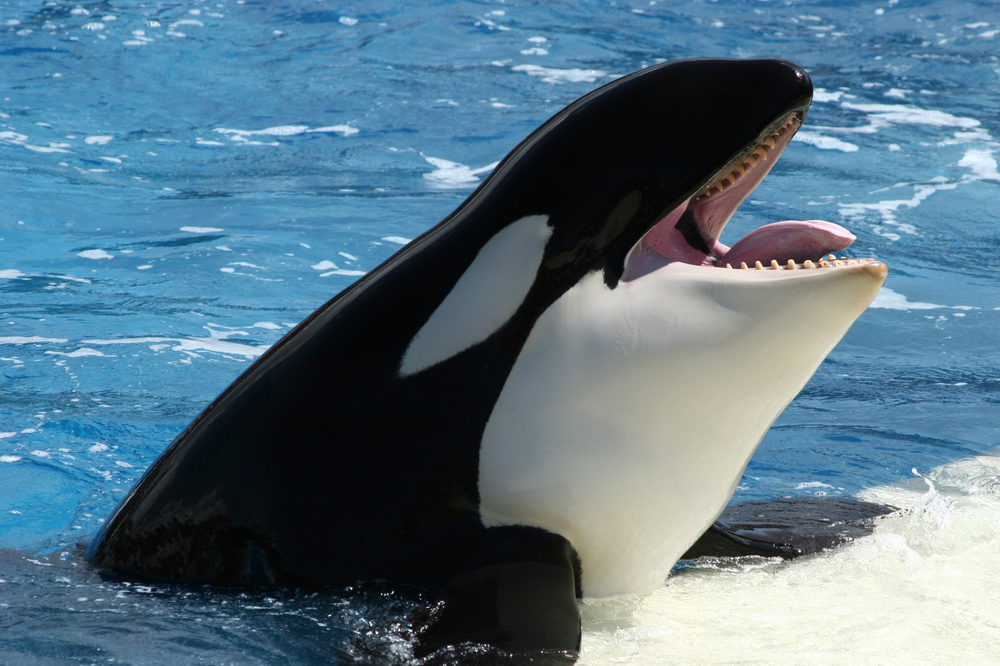
Meanwhile, three orcas are being fed in the holding pool located to the left of the show pool.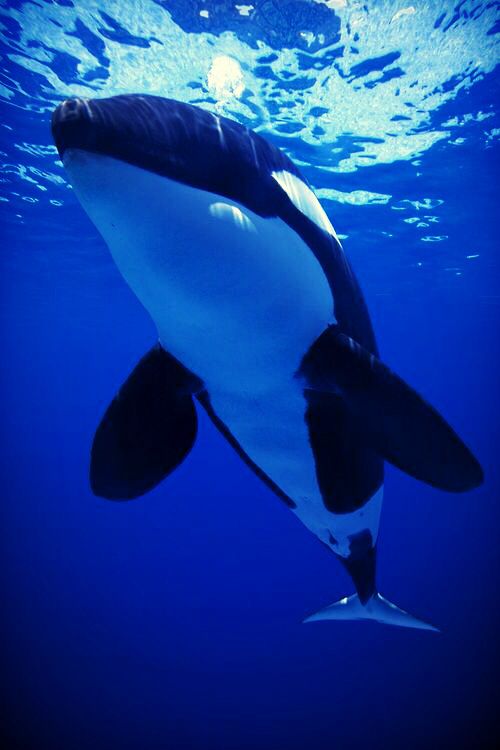
The bizarre and unnatural sight of orcas fully exposed on a hard surface always makes spectators cheer and applaud loudly. Male orcas Tekoa (in the front) and Keto, both with a fully collapsed dorsal fin, compliantly remain still on the slide-out and lift up their tail flukes, thereby giving crowds of holiday makers the opportunity to use them as photo ops. Credit: Helene O’Barry/Dolphin Project
Despite the orcas’ stagnant living conditions, Loro Parque calls the show “Life,” and spectators cheer and applaud as the orcas jump, spin around, and beach themselves on the concrete platform. Spectators scream in delight as Keto splashes water on them with his tail fluke.
As the show progresses, I get the impression that someone at Loro Parque has decided to respond to critics by trying to smokescreen the orca show as research, education, and conservation. They display numerous conservation messages on the backdrop, such as “We save endangered species,” “We promote conservation projects,” and “The animals need us.” And this one: “Maintenance of orcas under human care is an extraordinary opportunity to be able to investigate in controlled conditions the most important issues that orcas face in the wild.” It’s as if the orcas’ impoverished existence at Loro Parque’s amphitheater, where they can’t even swim normally, is warranted by using them as research objects as well as performers.
Loro Parque also uses the backdrop to inform spectators that orcas can use their powerful tail flukes to move lots of water.
Loro Parque features once-wild Morgan as the star of the show, and just like the four other orcas at the stadium, she has been trained to beach herself on command.
At the end of the show, a message on the backdrop encourages spectators to follow Loro Parque on social media, and a pre-recorded voice instructs: “If you want to know the truth, follow us.” During a show a few days later, Loro Parque tells spectators that they seek to “battle misinformation.” It appears that criticism from those who advocate for a ban on captive breeding and utilization of orcas as tourist attractions has made the zoo more determined than ever to convince spectators that orcas flourish in tanks and perform because they like it. But orcas in nature don’t wave or spin around on command, and they don’t beach themselves onto a concrete floor so humans can use them as photo ops. The human keepers train the orcas at Loro Parque to perform these unnatural behaviors, and their cooperation earns them rewards in the form of dead fish, ice cubes, and artificially colored gelatin.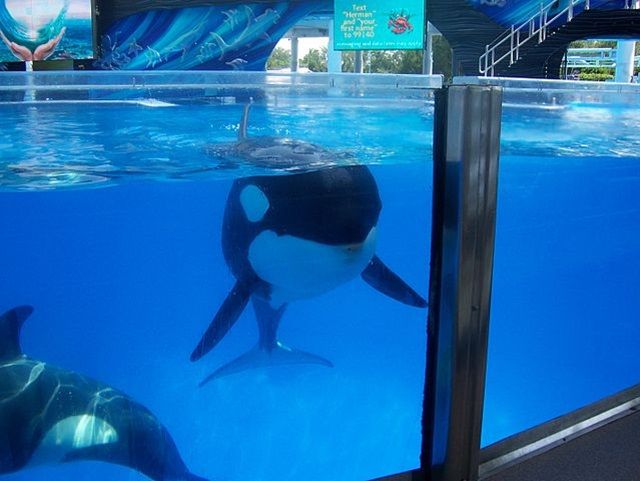
Holidaymakers are typically eager to buy tickets to see wild animals perform tricks on a stage, and as Morgan beaches herself on the concrete floor and stays there, fully exposed, spectators’ applause grows louder and louder. Their amusement at seeing this once-wild orca reduced to a compliant performer—trapped in a lifeless concrete box that bears no resemblance whatsoever to the ocean world she once belonged to—makes me fear that she and the others may never get out of here alive. When Keto, Tekoa, Kohana, Morgan, and Adan leave this planet one day, I suspect their flags, too, will mysteriously disappear from Loro Parque’s show stadium. It will be as if they never existed, and the enormous sacrifices they suffered at the hands of humans meant nothing at all.
Featured image: During shows at Loro Parque, orcas are repeatedly given the command to strand themselves on a concrete slide-out, something they obviously would never do in nature. Credit: Helene O’Barry/Dolphin Project
Loro Parque Thinks Foraging ‘Not a Big Deal’ for Orcas
On a hot, sunny afternoon, the orcas at Loro Parque in Tenerife, Spain, were working through the third killer whale spectacle that day.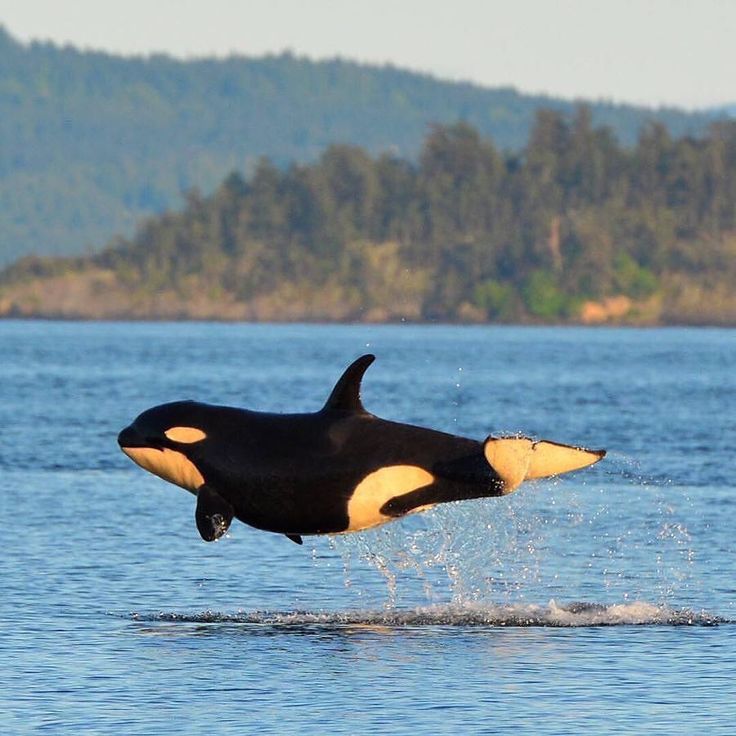
This is how trainers let the orcas know they did a good job and performed the trick correctly. Trainers at dolphinariums like to refer to this reward system as “positive reward,” but “food control” would be a much more accurate description.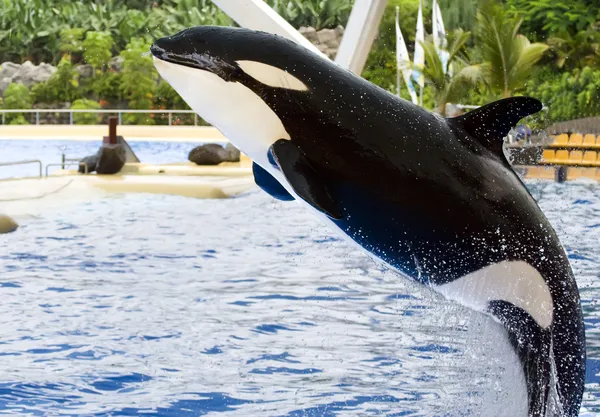
Making orcas perform shows by exploiting their fundamental need to eat is, in my opinion, highly manipulative and unethical. No dolphinarium administrator would ever admit that trainers enjoy a superior role in their relationship with the orcas. To conceal the unfairness, dolphinariums must give it a positive spin and make it appear as if the orcas enjoy and even benefit from being hand-fed. Loro Parque is a good example of how far a captive dolphin facility will go in its attempt to sugarcoat reality. It has produced a promotional video, titled Family of Orcas, dedicated to this very topic.
Trapped in small tanks and unable to forage on their own, captive orcas depend completely on their trainers for food. Credit: Helene O’Barry
One of the orca trainers, who is standing in front of the show stadium, says, “Welcome to Loro Parque, where Keto, Kohana, Skyla, Tekoa, Morgan, and Adán enjoy a safe, pollution-free environment in the most modern installation on the planet: Orca Ocean!” She goes on to say what is repeated like a mantra in dolphinariums around the world every single day: “They are ambassadors of their own species in the wild.” The music is upbeat, and the narration is accompanied by the orcas jumping and beaching themselves onto the concrete slide-out. They have been trained to act in ways that confirm the trainer’s cheerful message. With each jump, it is as if they say, “It’s really true.
So, according to Loro Parque, captive orcas are privileged to be hand-fed by humans, unlike orcas in nature who suffer the misfortune of having to plow through hundreds of kilometers of ocean water in hopes of finding something to eat. That is the picture that Loro Parque passes on to its audiences: At our facility, the orcas benefit from free food and no work. Life in captivity is so much better!
Toward the end of the video, the trainer talks about the special bond between the trainers and orcas, and how the behaviors orcas demonstrate during husbandry procedures as well as the shows are based on “positive reinforcement methods.
There is no mention of that, of course, and the last sentences of the video aim at persuading viewers to purchase tickets: “Come and discover Loro Parque for yourselves. Ninety-eight percent of our visitors are happy about their experience in our animal embassy, recognized as the second best in the world and number one in Europe, according to TripAdvisor!” The video shows an orca beaching itself on the platform and two orcas jumping in the background as if they just can’t contain themselves with happiness.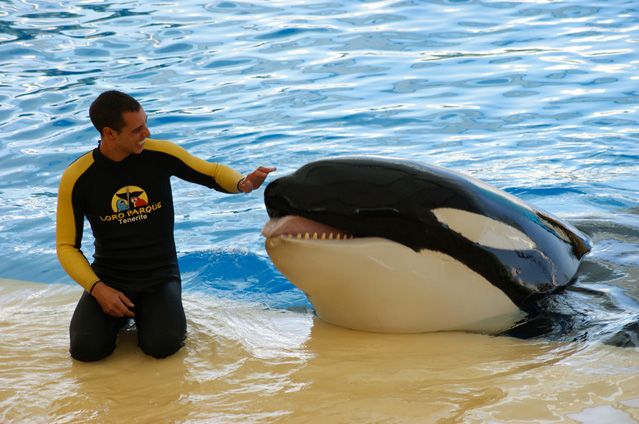
What is left out of Loro Parque’s video commercial is the fact that orcas in captivity do not receive their fish for free. They do work for their food. Trainers reward them with food during training sessions and shows when they perform a command correctly. This is how they are persuaded to perform the same abnormal behaviors over and over during rowdy, repetitive performances. Trapped in a concrete tank and unable to forage on their own, the orcas at Loro Parque depend on their human keepers to survive, and they know that. The powerless predicament that orcas suffer in captivity is what makes a 3-and-a-half-ton orca cooperate and perform silly dance moves on the concrete slide-out. Orcas should not have to perform such degrading stunts to entertain crowds of holiday makers, and they should not have to live on a diet of dead fish.
Keto opens his mouth to receive a chunk of gelatin, which is an artificial source of hydration for captive orcas.
One of the problems with this diet is that it can cause dehydration. Orcas and other dolphins don’t drink water. The only fluid they get is in the fish they eat. Live fish contain lots of fluids. A substantial part of that fluid is lost when the fish is frozen and then thawed. Therefore, captive orcas are also fed artificially colored gelatin and ice cubes. I have seen the trainers at Loro Parque feed the orcas buckets full of ice cubes and large chunks of yellow gelatin. Such an unnatural diet is not a privilege. It is one of the negative effects of humans putting themselves in charge of what orcas eat.
There is another, even bigger problem with Loro Parque’s description of how captive orcas are, in fact, lucky that they don’t have to hunt their own food. “They are not in need of swimming hundreds of kilometers in search of food,” the script reads. Loro Parque makes it sound as if swimming is a tedious burden that orcas would rather be without. It is a ludicrous statement that contradicts everything that orcas represent.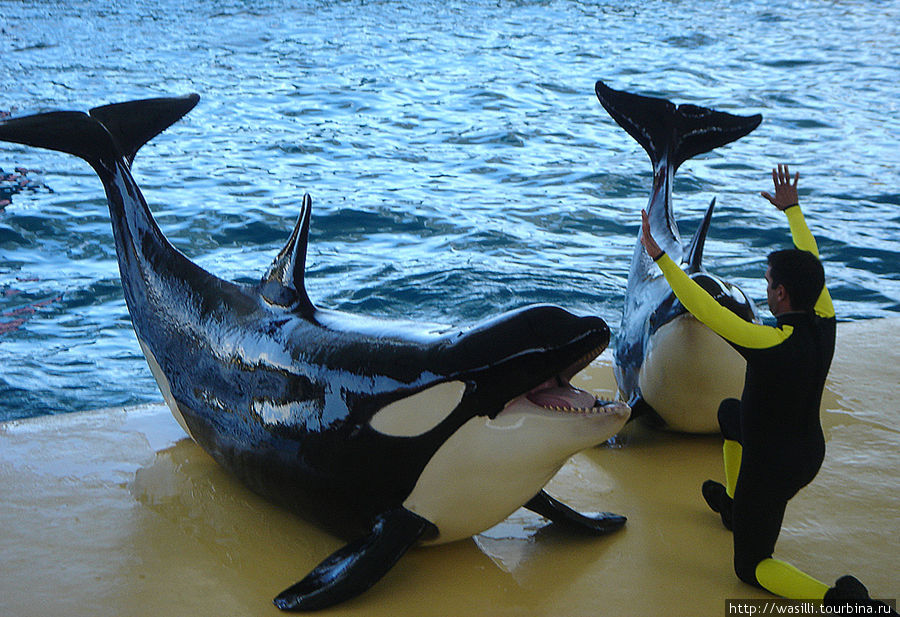
It is what orcas are all about, but Loro Parque apparently does not know that, or choses to ignore it. In its quest to justify confining a free-ranging marine mammal behind impenetrable concrete walls and iron gates, Loro Parque brushes the natural abilities of orcas aside as utterly irrelevant and unimportant. It is as if Loro Parque is not even aware that foraging, to orcas, is about so much more than just fulfilling their hunger. Orcas have evolved into a complex culture, and the most experienced orcas in the pod pass their tremendous knowledge to the next generation. That knowledge includes a variety of foraging techniques that bear testimony to their strength, speed, intelligence, and ability to communicate, cooperate, and strategize.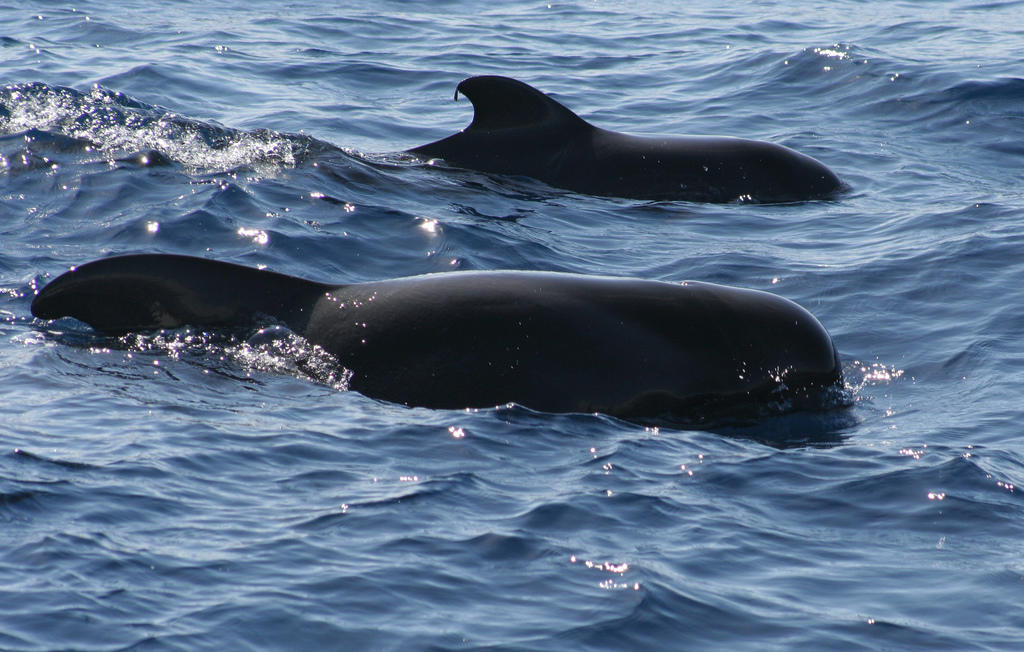
Unlike their relatives in nature, the orcas at Loro Parque will never use their sonar, communication skills, intelligence and speed to navigate, explore, and hunt live prey. Credit: Helene O’Barry
To belittle these highly evolved skills and imply that they are not a big deal comes from a place of supremacy. But humans have no right to keep orcas under such poor, barren conditions and act like it’s a privilege for an intelligent, complex being to live like that. Loro Parque wants us to believe that orcas, who in nature enjoy status as the ocean’s top predators, would rather not have to spend their time foraging! And this is a facility that claims to educate people about orcas. The notion that captive orcas are privileged because they don’t have to swim over long distances to hunt live prey illustrates a complete lack of understanding for everything that comes natural to these powerful predators.
The image of orcas that Loro Parque passes to its audiences is not education.
Featured image: During Loro Parque’s theatrical shows, the ocean’s top predators are being fed dead fish and ice cubes as rewards for jumping and dancing on command. Credit: Helene O’Barry
Sailing with Orcas and Pilot Whales
“Get out of the water! Get out!”, Andy shouted over the microphone. Swimming beneath the giant rock formations of Los Gigantes, on the western coast of the largest of the Canary Islands, had to be just a refreshing stop on our Whale Watching Tenerife tour.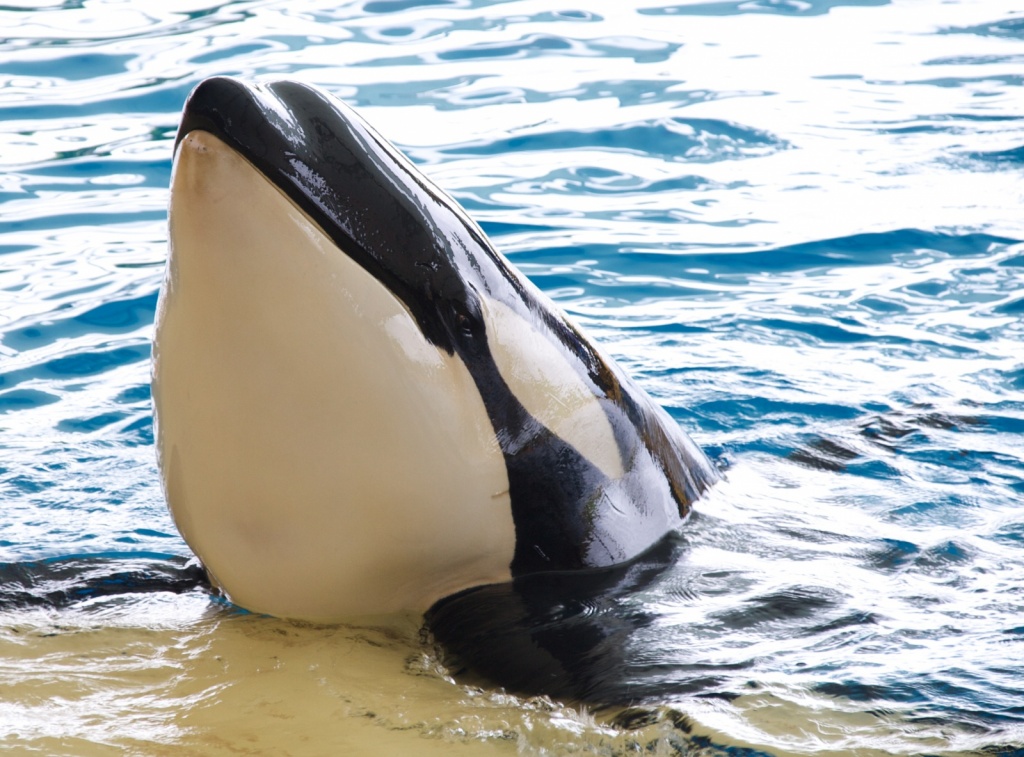
Shogun was an Arabic sailboat, 26 meters in length and 8 meters in width. Getting off of it was an easy task. One just needed to gather some courage and jump into the sea, with a supposedly 20-meter depth under the surface. Getting out was a different story. The boat ladder could support one person at a time. Cutting our swim break short was abrupt. Should we form a line to get back on board?
An unexpected event can quickly cause a stir
With five of us still in the water and the rest of the 40ish guests elbowing on the fence of the deck, the moment suddenly became darker. Even if the water was at its warmest (24 degrees in October), something sent chills down my spine.
Just a moment ago, the boat speaker played Pink Floyd. The song dispersed by the wave, and I swear I heard that nerve-racking theme song from “Jaws”.
“Oh no!”, yelled a girl heading towards the boat ladder, after something brushed her leg.
An older gentleman with glasses swam behind, startled and in panic.
In front of me, a bald beefy guy with a beard, in bright orange swimming trunks. I thought I would remember him from this trip only as a skin-burned someone who forgot to put on the sunscreen. I thought that would have been his most painful memory. But then…
Something grabbed him in the water.
Whales in Tenerife
Dorsal fins of pilot whales cutting the surface of the Atlantic
Belonging to the Canary Islands, the southernmost part of political Europe, Tenerife is geographically closer to Africa than mainland Spain. Just off the coast of Morocco, the seven islands are dwarfs without Snow White. It’s a place of eternal spring, with a year-long temperate climate!
Warm waters and a deep seafloor provide a hospitable home to rich marine life such as giant squid, jellyfish, and fish.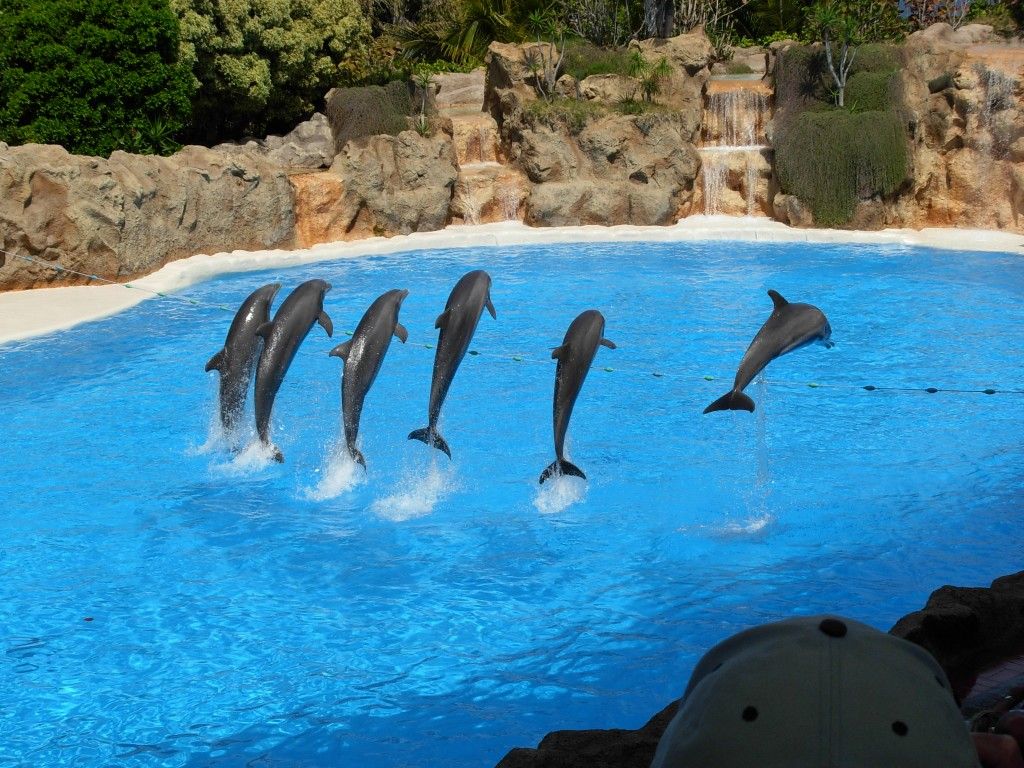
Sadly for them, they are also on the menu of cetaceans, the aquatic mammals that visit the channel between Tenerife and La Gomera.
For some, this open buffet restaurant is a perfect permanent habitat. For others, a nice bed&breakfast while they migrate through the Atlantic Ocean.
Approximately, one can see two dozen types of whales and dolphins in Canarian waters. From 300-kilo Risso’s dolphins to gigantic Sperm whales that can grow up to 60 tons, a variety of unexpected visitors can emerge during the whale watching excursions in Tenerife.
However, the most common residents of Tenerife waters, whose sighting probability reaches 90 percent, are Short-finned pilot whales.
With a slightly lower appearance chance ratio (50 %), the Bottlenose dolphins reveal themselves to the lucky ones, usually in groups of 10 to 30 specimens.
While there is a certain probability of encountering these majestic animals, Tenerife whale watching tours resemble a lottery.
Neptuno Sea Company tour guide Andy put it in a very basic language: “This is not a zoo or a theme park! This is the Atlantic Ocean!”
Tenerife is definitely a world-class location for observing whales and dolphins, but the realistic approach will prevent disappointments. There is no manipulation in nature. Effie Trinket‘s message in the “Hunger Games” can only express hope: may the odds be ever in your favor!
For guaranteed encounters with African wildlife, visit these Ethiopian lodges!
Can you see killer whales in Tenerife?
Killer whales or Orcas, the world’s largest dolphins, do visit Tenerife, but their appearances are quite rare.
These distinctive black-and-white predators were last seen in October 2018. They appeared near Los Cristianos, a small town on Tenerife’s southwestern coast, and attacked the pilot whale family.
However, there is one place where your chances of seeing killer whales in Tenerife grow to 100 percent! Sadly, it’s in Loro Parque, the zoo on the outskirts of Puerto de la Cruz, one of the island’s most popular tourist attractions.
Killer whale enclosure in Loro Parque is called Orca Ocean, but no artificial environment can replace the Atlantic
Loro Parque can boast about the world’s largest collection of parrots, the largest indoor penguin exhibition, and the largest show pool with bottlenose dolphins. Besides a variety of sharks, monkeys, sea lions, and wild cats, there are currently seven orcas in Loro Parque.
The killer whale enclosure in Loro Parque is called Orca Ocean, but no artificial environment can replace the Atlantic. Mothers rejecting their calves, rake marks on their bodies, missing teeth, and abnormal behavior of floating on the surface of the pool, are the less visible side of doing tricks for the audience’s pleasure.
Even if there have been no fatal attacks on humans recorded in the wild, Loro Parque did experience a couple of controversial incidents with two of the oldest orcas in captivity. One of these attacks ended with the death of an animal trainer.
Despite the criticism coming from a number of animal rights organizations and wildlife charities, Loro Parque in Tenerife remains one of the most popular zoos in the world.
With 20-something species of whales passing by Tenerife island on a daily basis, there is certainly a more animal-friendly way of paying respect to these beautiful creatures.
Shogun boat trip – sail Tenerife like an Arabian Sheikh!
The wooden Arabic sailboat serves the seas for more than four decades
I decided not to visit Loro Parque, and keep Puerto de la Cruz in vivid memories only through the Botanical Garden Tenerife. One of the most important collections of plants in the world was displayed in an exciting exhibition. And I had no ethical problems with it!
Whales were far better off in a natural surrounding of an ocean.
Neptuno Sea Company organized bus pick-ups in front of different hotels along the northern coast. The big red bus arrived at 9 am. We encircled the island over Santa Cruz de Tenerife all the way to Costa Adeje, the departure point for whale watching tours on the southwestern coast of Tenerife.
In Puerto Colon marina, tied for the pier number 14, there she was, floating in its glory. I wanted to call it a ‘she’, as sailing tradition enjoined. But instead of a female name on its teak shell, the wooden boat bore the name of Shogun, the title of Japanese military leaders.
This authentic sailing boat was constructed for the private use of an Arabian Sheikh in 1978. It was renovated in 2008, and it continued bringing glimpses into oriental luxury ever since.
The crew took souvenir photographs of all the guests right upon boarding, and we were ready to sail off.
Our first whale spotting in Tenerife
A game of hide-and-seek is on, but we have binoculars!
Pushed by the combined power of wind and motor, we headed north. The day was promising sunny weather. Wiser tourists, unlike that bald bearded guy in orange swimming trunks, started applying sunscreen. The wind was filling Shogun’s red sails, but it also caressed our sun-exposed skin, until it was too late. Maybe exactly because of that reason, the bald guy in orange swimming trunks would stay a minute longer in the waters of Los Gigantes later, surrendering to the calming effect of the sea.
Fish farms we passed by often attract bottlenose dolphins looking for easy prey.
The depth of the sea between the islands of Tenerife and La Gomera can reach up to 2.400 meters. Finding whales and dolphins suddenly resembled looking for a needle in a haystack. The ideal feeding ground for these fantastic mammals was also a vast blue membrane to hide under.
The crew used binoculars to scan the territory of the whales. The sentence “This is the Atlantic Ocean, not a zoo” suddenly sounded like a preventive alibi for possible failure.
But then the boat engine went silent. Out of nowhere, almost like deus ex machina, two dark shadows scratched the surface of the sea. “Look over there!”, someone shouted.
A mother and her baby quietly traveled the channel. Our silenced breathing was only cut by mist pluming out of the whales’ blowholes. What a beautiful spectacle!
Sleeping giants of the Canary Islands
The first thought was that the homemade Canarian sangria, slightly stronger than the one you could find on the Spanish peninsula, made us see double. But in fact, a family of two pilot whales had let us enter their calm universe for a minute. Unconstrained by the theme park industry, this “orca ocean” was a world where mothers did not reject their cubs but swam together as the only survival method.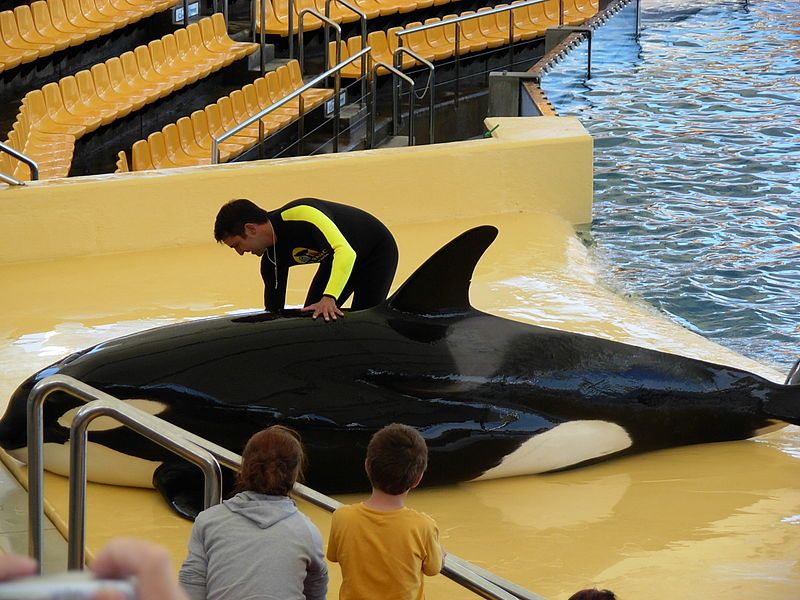
Pilot whales can grow up to six meters, and can weigh up to two tons! To maintain that size, a rich diet of squid, octopus, and small fish is employed. They typically feed by night and sleep by day.
Mom and baby whale swimming side by side
When we saw them emerging on the sea surface, we witnessed the behavior called logging (floating like a log). It is basically – a nap. Whales are mammals, so they cannot breathe underwater. In order to recuperate from the night hunting efforts, they engage in surface resting combined with logging, during which only one-half of their brain sleeps at any moment. The other half has to beware of the surroundings and remind the whale it’s time to breathe in.
The stars of our whale safari slowly navigated the channel, and at one point even crossed under our boat. After some time of observing the whales, we would continue on, and then encounter a few more of these “sleepswimmers”. Or is “sunswim” the correct version of what we call moonwalking in the human world?
There is something humbling in meeting these marvelous animals face-to-face.
In one city in Japan, wild animals practically became its citizens. Check out the Nara Deer Park!
Something is lurking in the waters of Los Gigantes
Anchoring in a bay seems like a perfect moment for a cooling swim, and there’s a camera to record your master dive
We continued towards the Bay of Masca and anchored under the impressive Acantilados de Los Gigantes (Cliffs of the Giants). Not everyone jumped at the opportunity for a swim break at the foothill of 600-meter-high cliffs.
The massive rock wall rising out of the sea looked both spectacular and intimidating. A sturdy end of the volcanic island, overlooking the dark Atlantic waters.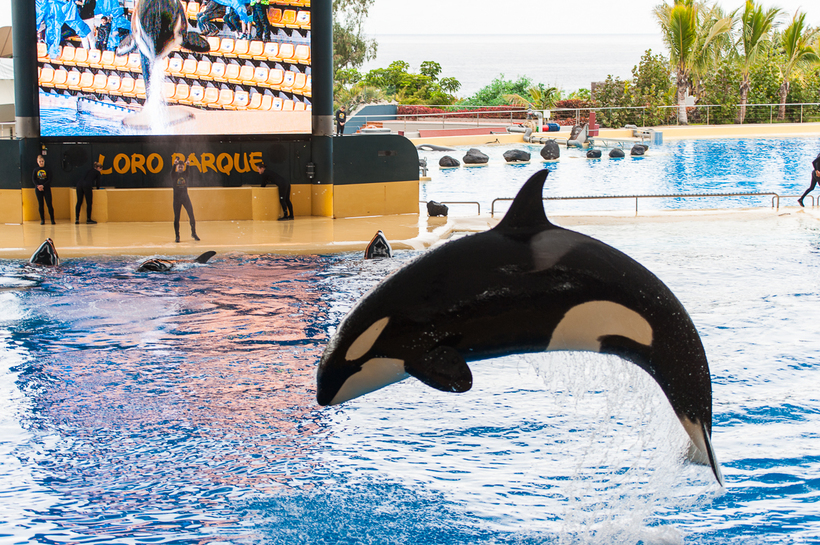
A dozen of us decided to seize the Tenerife whale watching day with an energizing swim in the vicinity of the stunning natural wonder of Los Gigantes. The depth was such that, despite the proximity of the island, no one could see the bottom of the seafloor.
A call for lunch and a tempting smell of vegetable rice and roasted chicken drumsticks saw most of the swimmers heading back to the boat. With five of us remaining in the water, the crew started throwing pieces of bread into the sea, and tropical fish developed an appetite too.
Andy the guide, the sangria maker, and the DJ, all-in-one, decided to spice up this unusual picnic in the wild. The music that spilled out of the loudspeakers was appetizing, but only for great white sharks that watched the 1975 blockbuster.
It’s fascinating how John Williams’ ingenious composition successfully carved into our collective memory and invoked the feeling of panic we associated with Steven Spielberg’s thriller.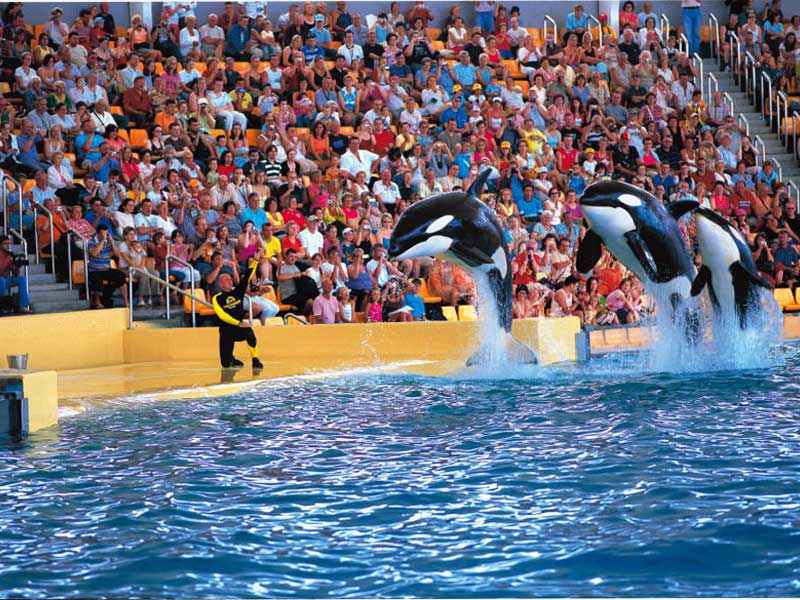
The suspense was in the air. It provoked some hysterical laughter, but also the sense of real approaching danger.
I decided to garnish the musical accent of the “Jaws” theme by grabbing the bald guy in orange swimming trunks underwater. Fear is best fought with laughter.
We were all out of the water in no time!
Neptuno whale experience – adventurous and fun
There are many ways to remember the sailboat excursion; one is by not bringing the sunscreen
Hopping on the Tenerife whale watching excursion with Neptuno Sea Company provided an expedition that was fulfilling in a variety of aspects. It brought new insights, and loads of entertainment, while at the same time never jeopardizing the safety of passengers or whales.
The return to Puerto Colon after lunch was an opportunity to reflect on this adventurous day trip while soaking up the sun on the chill-out deck.
Those hanging at the disco deck had the privilege to order music of their liking. We were saying goodbye to the whales with Scorpions and Queen, holding Caipirinha in one hand, and cameras in the other.
In the last half hour of the trip, a speedboat raced toward us and docked sideways, as in some James Bond movie. The girl embarked Shogun with sets of freshly printed souvenir photos that combined our portraits from the marina and photos of whales and dolphins. One cost 10 Euros, two 15.
For those who preferred the video footage (and let’s face it, “Jaws” remained in my memory because I saw them first with 3D glasses), the company offered a DVD. It compiled the shots of the Tenerife wildlife over the years (blue whales, killer whales, jumping dolphins, etc.), aerial views of the island recorded by drone, and the highlights of the very trip we just participated in. The DVD cost 34 Euros.
If you wanted just a little something to remember the Tenerife whale watching experience, there were souvenir necklaces made of nakar. The local artist was selling one for 5, or two for 8 Euros.
Tenerife whale watching price
DJ Andy is also a barman Andy; sangria on a sailboat is a perfect way to make both your body and mind float
If you choose a Tenerife whale watching trip on Neptuno’s Shogun, the 5-hour experience will cost you 50 Euros per person, with free pick-up on southern shores.
You can book your whale watching tour securely through this link.
There’s a cheaper way to see pilot whales and dolphins with the same company. If you decide on a 2-hour trip on an authentic Portuguese Goleta Peter Pan, this smaller-group whale experience with simple sandwiches will cost you 25 Euros per person. The departure point for this whale watching tour is in Los Cristianos, the fishing village south of Playa de las Americas.
Children aged 6 to 11 pay half of these prices, while younger ones get on for free.
Soft drinks are complimentary on Neptuno trips, as well as a beer or wine with your lunch. Any extra alcoholic drink will cost you an additional 1 Euro, as well as Espresso. Regular coffee is 50 cents.
I sincerely recommend staying on the less-touristy northern coast of Tenerife.Check the best accommodation options in Puerto de la Cruz!
How to ensure responsible, ethical, and eco-friendly whale watching in Tenerife?
In order to protect the new generations of pilot whales, support only legal operators!
In order to secure the sustainability of whale watching in Tenerife, rules have been implemented for the tour boats. To make sure that disturbance of the animals is minimized, Tenerife Turismo regulated the speed, approaching zones, distances, whale watching duration, the concentration of boats, noise and other pollution, etc.
The companies that comply with the regulation of responsible whale and dolphin watching in Tenerife can be identified by the Blue Boat Flag (Barco Azul).
Some boats certify their whale watching programs as ethical through other labels, such as the World Cetacean Alliance and Friend of the Sea.
Neptuno is an experienced boat tour company operating since 1994.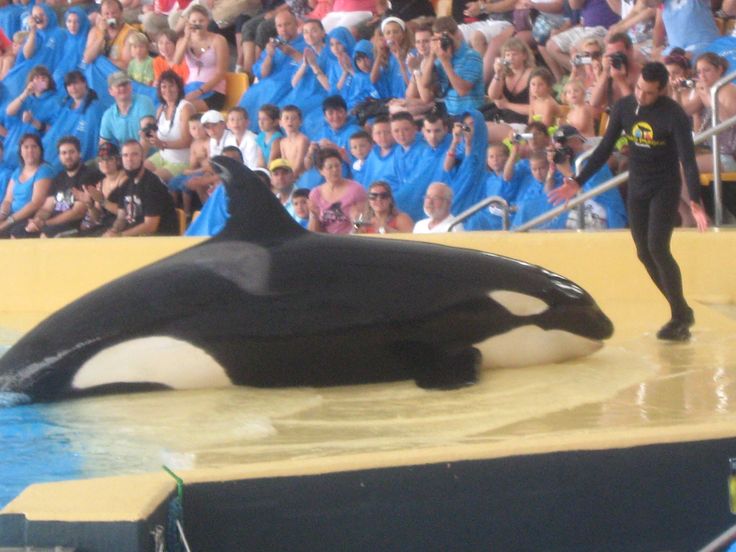
If you would like to explore whale watching in Tenerife even further, the Atlantic Whale and Dolphin Foundation offers volunteering programs. They start at 300 Euros per week, which includes accommodation, meals, and activities.
When to see whales in Tenerife?
Tenerife is a year-long tourist destination and whales think the same way too; invest patience and you will certainly spot some of them whenever you visit!
What are the best months for whale watching in Tenerife and the Canary Islands? Thanks to the climate and the quality of the habitat, pods of pilot whales and bottlenose dolphins live permanently in the Tenerife water area. This means you can observe them throughout the year!
Sperm whales should be around Tenerife all the time too but are hard to see. Your chances to meet this evasive species that prefers the ocean depths grow in March and April.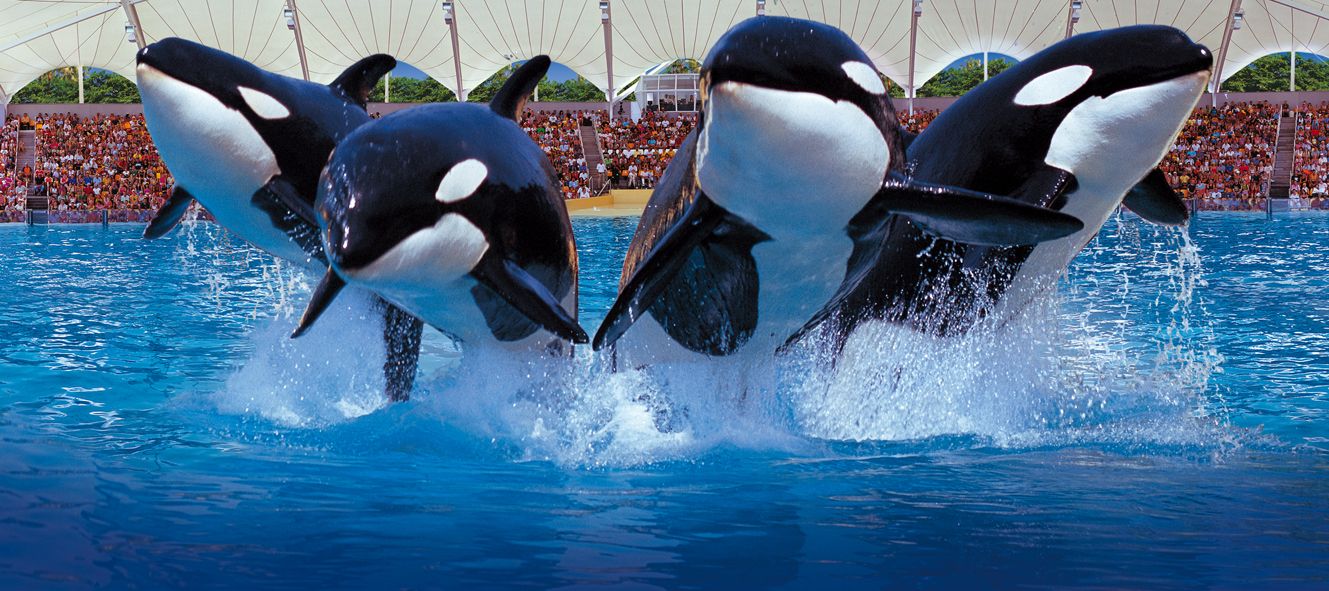
Springtime is also a good period for trying your luck with killer whale watching in the wild.
As for the rare sightings of other migratory whales, you’ll have the best chances to spot them between November and February. This is the period when humpbacks, fin whales and blue whales pass by Tenerife.
Finally, when speaking about whale watching in Tenerife, there is no such thing as the best time of year. These are free-roaming animals!
Whale watching season in Tenerife never stops, and the close encounters depend only on the whales’ will to reveal themselves.
Did you like this article on the whale watching in Tenerife?
Pin it for later!
Disclosure: My participation in Neptuno Sea Company's boat trip was complimentary, but all opinions are my own. Also, this post contains affiliate links, which means if you click on them and make a purchase, Pipeaway might make a small commission, at no additional cost to you.Thank you for supporting our work!
Ivan Kralj
Editor
Award-winning journalist and editor from Croatia
Loro Park Puerto de la Cruz Tenerife
Loro Park is Tenerife’s most popular wildlife centre home to over seven hundred parrots with over a million visitors every year. Also known as ‘Loro parque’ in Spanish its a man-made paradise that has also become home for many other rare and exotic creatures from around the world featuring parrots, killer whales, sea lions, dolphins, penguins, sharks, gorillas, chimpanzees, jaguars, tigers, alligators and many other creatures. You will need a full day to enjoy the entire park. It’s not to be missed and is a great day out for the whole family!
How to Get There
Loro park is in Puerto de la Cruz, in the north of the island. Because of its popularity with holiday makers from around the world, you will find that getting to the park is easy. On the TF-5 motorway take exit 39 and follow the Loro Park signs. GPS Coordinates: 28°24’33.2″N 16°33’57.5″W Click to view on Google maps.
Opening Times:
The park is open every day from 08:30 till 18:45
Click HERE to download the Map Guide / Timetable
Attractions and animals at Loro Park
Orcas Ocean
Orca Ocean at Loro Parque is a huge project carried out in conjunction with Sea World in the USA. The orcas are between 5 and 13 years old and they belong to third generation orcas born in captivity at Sea World´s facilities. The four orcas live together in harmony in the most modern installations in the world, with pools that are between 8 and 12.5 metres deep and 120 metres long. A fantastic home were they can swim and play placidly. The 22.5 million litres of sea water that fill the pools is pumped directly from the Atlantic Ocean from a depth of 65 metres. The pools are at constant temperature of 13ºC.
Dolphin Pool
The dolphins are probably the most favourite. Their great intelligence and the special empathy they have with human beings make them a perfect companion. It is understandable why this is one of the most popular shows at the Loro Parque. The dolphin pool, is one of the most modern in the world with its 7 million litres of sea water which is distributed between the different pools. The stadium also has a capacity for 1.800 people. The acrobatics and loops made by these amazing cetaceans are incredible, with jumps reaching a height of more than 6 metres. Their gentle and playful personalities conquer the hearts of all the public.
Sea lions Amphitheatre
If there is one animal renowned for their acrobatics, balance and charm, these are, without doubt, the Californian sea lions. These funny marine mammals bring laughter to the whole family with their great sense of humour. The public can see the sea lions agility and their funny movements in the water through a glass window that allows underwater vision. The show is a mixture of games, balance, ballet and dramatic jumps. But without doubt, what these animals enjoy the most is to tease their trainers.
Parrots
The parrots also have a very entertaining show where you can enjoy their beauty and intelligence. With a tradition of over 30 years, the show is now housed in a majestic Arabian palace and has a capacity of 600 people. The parrots are so funny and enthusiastic with their pranks and escapades and the most impressive moment of all is when they release them and you see them circling, flying free, almost brushing the top of your head.
Penguin Planet
As you go through the ice tunnel you will see some of the most special inhabitants of Loro Parque, the Antarctic Penguins. Planet Penguin is the biggest replica of the Antarctic continent ever constructed. There is snow, ice and it´s just as cold as you would imagine it would be in the Antarctic 0º. They produce 12 tons of snow a day so that the penguins feel at home especially as the water temperatue is kept at 7º. In this area you can see four different species of penguins: The Kings, Gentoos, Chinstraps and the Rockhopper penguins.
Aquarium
With a total of 1.200.000 litres of water, visitors can contemplate seven different theme exhibits, even recreating the ecosystem of different parts of the world. One of these is a natural living coral reef, built from original volcanic rock brought from the south of Tenerife, which was covered with living coral, both hard and soft, from Indonesia. In this incredible variety of aquatic life, you can observe all kinds of colourful fish. The most impressive area of the aquarium is the acrylic Shark Tunnel, 18 metres long, where you can see the biggest predators that live on the edges of the reefs; Gray, Black Tip and Nurse sharks.
Naturavision
The impressive glass dome cinema shows an HD movie called Planet Life, only seen at the Loro Park. The movie has incredible scenery of planet earth, showing you dramatic environments, similar to the ones in Loro Parque and some of the most remote places on earth.
Kinderlandia
Kinderlandia is dedicated to the amusement of our younger visitors and here they will find the best and most enjoyable things for them to do. Here you can also celebrate special occasions like birthdays. Kinderlandia is just like an African village of huts in trees where children can climb and enjoy the jungle, balancing on the hanging bridges and slithering down the snake slide. Or, try out the Orca roller coaster! It´s the very first one in the Canaries!
Gorillas
Loro Parque houses the largest group of male Western Lowland gorillas in the world. The park has become a pioneer amongst zoos to recreate this social structure in captivity and in 1992, together with the European Breeding Programme for Animals in danger of Extinction created a genetic reserve of these gorillas.
Bengal Tigers
Loro Parque is home to two white Bengal tigers called Yangyu (male) and Linmao (female) they originally came from the Guangzhou Xiangjiang Zoo in China and are an endangered species. These smart and cunning cats enjoy their great home surrounded by vegetation, a waterfall and a lake for for their exclusive summer dips.
Katandra Treetops
Katandra means “song of the birds” and this attraction puts you within a heartbeat of Australia´s famous feathered friends. This free flight aviary is one of the most impressive you will ever see, with hundreds of birds from different species and subspecies. Explore this amazing habitat as you wander jungle walkways and traverse hanging bridges searching for colourful birds. Meet face to face with loris, cockatoos, emus, laughing Kookaburras and many more other species in this mysterious jungle atmosphere.
Chimpanzees
Chimps live in family groups in Central Africa and usually consist of 15 to 50 animals, ruled over by a union-fission culture. The chimpanzees were rescued by Local Authorities from street photographers who used them to pose with tourists. Fortunately they were donated to Loro Parque.
Prices:
There are many companies providing excursions to the park at very reasonable rates. Simply check with your tour operator or holiday rep once you arrive on Tenerife!
Normal Price
Adults (12 years and above) 33 €
Children (6 to 11 years old) 22 €
Special discount for residents
Adults (12 years and above) 19. 50 €
Children (6 to 11 years old) 13 €
Address:
Loro Parque, S.A.
Avenida Loro Parque s/n
Puerto de la Cruz 38400
Tenerife – Canary Islands
Contact Details:
Telephone: +34 922 373 841
Fax: +34 922 375 021
Loro Park Website in English:
http://www.loroparque.com
Performing animal attraction says it is “completely impossible” to free orcas into the sea : The Canary
Orca at Loro Parque splashing delighted tourists as part of a “performance”
Loro Parque, on Tenerife, are one of a dwindling number of tourism attractions around the world that profit from the exhibition of performing captive animals, and who maintain their activities through breeding programs. Many of their animals are forced/trained to perform unnatural “tricks” for the public, so as to receive food, in some places punished for not performing “correctly” and kept in cramped conditions that are distinct and very much smaller than their natural habitats.
A recent Canary Islands law could lead to the eventual banning of all such unnatural performances, and tour operators are refusing to sell such excursions, but for now these big businesses still claim they are doing nothing wrong, and only care about the animals’ welfare… animals from whom they also earn a tidy profit.
“Experts” paid by Loro Parque have reaffirmed today that in their opinion it would be “completely impossible” to release in to the sea the killer whales that currently live in concrete tanks at their tourist attraction in Tenerife, and that even their re-homing to a sanctuary would not improve their well-being, in fact they say “just the opposite”.
In a letter responding to the growing tide in criticisms received about the existence of performing orcas at this “zoo” exhibition, Loro Parque have made it clear that these are “hybrid animals” (mixed between orcas from the Atlantic and Pacific oceans) and that no administration of any country would allow them to be released, due to the danger of genetic contamination of wild populations of this species.
This in part sounds like a sane argument
In addition, the park adds that being second, third and fourth generation animals under human care they have never learned to hunt their prey and point out that the only known liberation of such an orca born in freedom and then kept 20 years in a zoo (that of world famous killer whale Keiko, who starred in the movie “Free Willy”) showed that it is not possible for these animals to recover the ability to hunt their own food.
So one famous whale was released, once, and did not fair well. Sounds like a fair basis on which to decide the abilities and needs of an entire species… erm, no wait…!
The health authorities, they say, would not allow the animals to be released into the sea, since it would enable the release of bacteria, fungi and parasites that have been treated with drugs and could cause serious epidemics in dolphins and wild whales, adds the letter from Loro Parque.
Sounds like they have been dealing with some serious ailments in those tiny concrete tanks in which their orcas are forced to live.
In the opinion of the tourist attraction, the best proof of the inability of captive orcas to adapt to life at sea was the release of Keiko, which after more than three years of work and 20 million dollars resulted in the death “of a wonderful animal that was unable to hunt on its own” the park adds.
For almost 46 years, Loro Parque has profited from the exhibiting of many captive animals that, they say, needed help and in the case of killer whales, they named Skyla, Kohana, Tekoa and Keto who joined them in 2006, as well as Adam (born in captivity at the center in 2010) and of course Morgan, the controversial orca “rescued” on the shores of the Wadden Sea in the Netherlands and never re-released, according to the park who acquired her in 2011, as they said she needed their protection due to being “profoundly deaf”. Campaigners say she was illegally purchased and transported for private exploitation. The park have since carried out a successful insemination program to breed more captive orcas who will under law be their exclusive property.
“Today the six orcas that Loro Parque hosts” say the park “are in perfect condition, their health is monitored daily by a team of veterinarians and their needs attended by a group of expert caregivers,” .
Loro Parque have criticized internationally recognised activist groups, such as PETA (People for the Ethical Treatment of Animals), the Born Free Foundation and the Free Morgan Foundation, that petition various administrations for the release of these animals, or who demand their transfers to marine sanctuaries, saying that they regret that this “pressure” is also transferred to tour operators and tourist companies.
Reputable tour operators, including TUI and Thomas Cook, have refused to sell excursions to their clients if there are to be captive animals forced to perform for their audiences.
![]()
The tourist attraction in Tenerife, much mired in controversy over the years, has stated that it is only anti-zoo organisations who claim killer whales are not happy in these centres since, according to their knowledge, there have been no researchers from independent universities with academic knowledge and accredited experience on animal welfare to corroborate these claims.
Tilikum in a scene from ‘Blackfish’
Erm… the link between psychosis, self harm, violent behaviours, depression and illness in captive performing animals, in particular cetaceans like orcas, is pretty well established… there are very specific reasons why companies like Sea World have been in serious trouble and have closed exhibitions over recent years, namely bad practice, public shock and their failure to understand the science, in the name of protecting their own profits. Most famously the film “Blackfish” went a very long way in educating the public on the realities of captive orca exhibitions and the problems with the conditions of their keeping and performance training.
![]()
Loro Parque say that the demonstrations and campaigns by these groups are not based on measurements of hormones, rigorous research on behaviour or careful scientific studies evaluating the personality or activity of the animals but instead “prejudices and speculations that have never been proven”.
The Tenerife tourism centre states that they have independent studies from welfare experts from the Autonomous University of Barcelona, the University of Las Palmas de Gran Canaria and the Max Plank Institute that conclude that the welfare of these animals is very high.
For Loro Parque, it is “very naive” to think that killer whales that have been living in zoos for several generations will automatically swim longer distances in sanctuaries just because they are in a larger place.
In the sanctuaries, they say, the nutritional needs of the killer whales would be the same as those of a zoo, that is, they would have to offer them 8 or 9 meals a day, that would represent more than 300 kilos per day of high quality fish and they say that the maintenance of an orca supposes a cost around $600,000 per year, so the sanctuary would need to generate at least $3. 6 million each year for the next 40 or 50 years.
“Considering the difficulties that the shelters of dogs and cats have, to maintain much lower costs, it is possible that in a few years these expenses must be paid with the taxes of all citizens,” concludes Loro Parque in its extraordinary statement.
Source: La Provincia
Extra commentary: Editor
Keto | Killer Whale Wiki
in:
Living Orcas in Captivity, Captive-born Killer Whales, Hybrid Orcas,
and
3 more
View source
Keto
Keto breaching. Photo provided by Diva Flora.
Sex
Male
Date of Birth
June 17th, 1995
Place of Birth
SeaWorld Orlando, Florida
Weights
- 350 lbs (Jun. 1995)
- 7,495 lbs (Apr. 2013)
- 8,600 (2015)
Lengths
- 7 ft (Jun.
1995)
- 20.5 ft (2015)
Ecotype
75% Icelandic Resident, 25% Southern Resident
Mother
Kalina
Father
Kotar
Calves
Adán, Victoria, Ula
Siblings
Keet
Half-Siblings
Kahana’s Miscarriage (1990), Takara, Kenau’s Unborn Calf (1991), Samoa’s Stillborn (1992), Haida II’s Calf (1994), Kalina’s Stillborn (1997), Tuar, Skyla
Grand-Parents
Katina, Winston
Aunts & Uncles
Baby Shamu II, Kandu V’s Stillborn (1986), Katerina, Taku, Unna, Ikaika, Nalani, Makaio
Nieces & Nephews
Kohana, Trua, Unna’s Stillborn (2006), Kayla’s Miscarriage (2007), Sakari, Adán, Takara’s Miscarriage (2012), Victoria, Kamea, Amaya, Kyara
Cousins
Trua, Unna’s Stillborn (2006), Nalani
Keto (pronounced kee-TOH or KE-toh) is a 27 year old male killer whale who lives at Loro Parque in Tenerife, Spain. He was born tail-first on on June 17th, 1995, at SeaWorld Orlando. He is one of the few killer whales who has lived at all four SeaWorld parks in the United States, including the now closed SeaWorld Ohio. Keto has fathered three calves: Adán and Victoria, who were born to Keto’s half-niece Kohana and are 6.25% inbred, and Ula, who was born to Morgan. Keto is described as a dominant whale.
Contents
- 1 Early Life
- 2 Life at the SeaWorld parks
- 3 Life at Loro Parque
- 3.1 Calves
- 4 Behavioral Incidents
- 5 Trivia
- 6 Galleries
Early Life
Keto was born on June 17 to mother Kalina and father Kotar at SeaWorld Orlando in 1995. He was born tail first and is Kalina’s second calf. Kalina showed good maternal instincts towards him when he was born. As he got older, Keto was nicknamed ‘punk’ by his trainers because of his disruptive and rebellious behavior. Due to this reason, Keto was transferred to SeaWorld San Diego in 1999, then four years old, to correct his behavior.
Life at the SeaWorld parks
On arrival in SeaWorld San Diego, Keto met his full blooded brother, Keet, for the very first time. The two got along very well. Keto and Keet stayed at the San Diego park for 9 months, and on April 15th 2000, they were both transferred to the now-closed SeaWorld Ohio park (also known as SeaWorld Aurora), along with Sumar, another whale who resided at SeaWorld San Diego at that time. When the summer season ended, Keto was transferred a third time to SeaWorld San Antonio, leaving his brother Keet behind. Keto arrived in Texas on February 18th, 2001.
At SeaWorld San Antonio Keto met a female named Kayla. Due to the displaced social structure that was happening after the death of the matriarch, Haida II, Keto grew very attached to Kayla and would often display dominant behaviors towards other male killer whales, especially Kyuquot, when paired with her. His dominant behaviors continued when Tekoa and Tuar, two whales from Orlando, arrived at the park.
At the age of 10, Keto was transferred for the fourth and final time to Loro Parque, a small zoo located in Tenerife, Spain, on a breeding loan. Keto was transferred with three other whales: Tekoa, Kohana and Skyla. Despite being sent there on a breeding loan, Keto was related to both Skyla, who was his half sister, and Kohana, who is his niece.
Life at Loro Parque
Keto arrived at Loro Parque on February 13, 2006. Shortly after arriving, Keto ingested pieces of Metflex, a substance used to waterproof the tanks at Orca Ocean. An endoscopy was subsequently preformed on Keto. A video recorded of the procedure surfaced shortly after showing Keto raised on a rising-platform in the medical pool thrashing while his trainers attempt to preform the endoscopy.
Calves
Keto has fathered three calves as of 2018. Adán, born in 2010 to Kohana, Victoria (or Vicky), born in 2012 to Kohana, and Ula, born in 2018 to Morgan. Both Victoria and Ula have since passed away while Adán remains at Loro Parque.
Behavioral Incidents
- In September of 1998, 3 year old Keto pushed his trainer around the pool, open-mouthed.[1]
- In March 1999, just days after his transfer from Florida, Keto swam into his trainer open-mouthed.
- In December of 1999, Keto snapped at his trainer during a training session.
- In August of 2002, Keto swam into his trainer open-mouthed once again.
- In September of 2009, an incident between Keto and trainer Brian Rokeach was noted by fellow trainer Alexis Martinez.
- On December 24th 2009, 29-year-old Alexis Martínez had been killed by Keto during a training session. The accident occurred at 10.30 am during the first training session for the Christmas Special planned for the New Year. The other 7 trainers were also present in the training session. Alexis was hit by Keto, and his death was caused by drowning because he was under the water unconscious for several minutes before he could be rescued. The autopsy report on Martínez was telling and states bluntly that his was a “violent death.
” It describes multiple cuts and bruises, the collapse of both lungs, fractures of the ribs and sternum, a lacerated liver, severely damaged vital organs, and puncture marks “consistent with the teeth of an orca.” It concludes that the immediate cause of death was fluid in the lungs (i.e., drowning) but that the fundamental cause was “mechanical asphyxiation due to compression and crushing of the thoracic abdomen with injuries to the vital organs.” In other words, Keto must have slammed into Martínez with such force that he caved in his chest.[2]
Trivia
- Keto’s name originates from the ancient Greek word “kētŏs,” meaning large sea monster.
- Keto is often nicknamed “Oslo” by his trainers and his fish buckets are labeled ‘O’ instead of ‘K’, his actual initial, like the rest of the whales’ buckets are. It is unknown why or where it originates from.
- Keto is 25% Southern Resident.
| FROM: | TO: | ON: |
|---|---|---|
| SeaWorld Orlando, Florida | SeaWorld San Diego, California | Mar. |
| SeaWorld San Diego, California | SeaWorld Ohio, Ohio | Apr. 15, 2000 |
| SeaWorld Ohio, Ohio | SeaWorld San Antonio, Texas | Feb. 18, 2001 |
| SeaWorld San Antonio, Texas | Loro Parque, Spain | Feb. 13, 2006 |
Galleries
- Photos of Keto
- Videos of Keto
- ↑ https://www.onegreenplanet.org/animalsandnature/keto-the-other-whale-who-killed-his-trainer/
- ↑ https://www.outsideonline.com/outdoor-adventure/environment/adventure-blood-water/
Community content is available under CC-BY-SA unless otherwise noted.
Views | Whale watching
There are 21 different species of marine animals in the waters here – from the giant blue whale to the sinister killer whale. It is not easy to distinguish them from each other in the open sea in appearance, especially if they swim far from the boat. However, if you look closely, you can identify them even at a distance by certain characteristic features: size, shape of the head, dorsal fin, body and tail, as well as behavior.
-
Permanent residents: live in the area all year round
-
Bottlenose dolphin (Tursiops truncatus)
This is the most common species of dolphin that can often be found near the coasts of Tenerife. The average body length of a male is 2.7 meters, a female is 2.5 meters, while the body of the largest dolphins can exceed 3 meters. They live in packs of 10-30 individuals, the dark gray color of the back becomes lighter closer to the belly.
-
Tropical pilot whale (Globicephala macrorinchus)
Also known as pilot whale or short-finned pilot whale, it belongs to the dolphin family. Pilot whales have teeth (suborder toothed whales), and got their name due to their size – they can reach 5 meters in length and weigh 1-2 tons.
This species is most often found during excursions to their habitat.
-
-
Occur singly: rare throughout the year
-
Atlantic spotted dolphin (Stenella frontalis)
This species is characterized by specks that cover its entire body in adulthood. They live in large flocks and are very active. Most often they can be found from autumn to late spring. Weight: 60-80 kg. Body length: up to 2.3 meters.
-
Large-toothed dolphin (Steno bredanensis)
This species is characterized by vertical grooves on the teeth and an elongated skull. It is darker than bottlenose dolphin and has spots. They live in packs of 6-10 individuals. Weight: up to 150 kg. Body length: up to 2.7 meters.
-
Bryde’s striped whale (Balaenoptera edeni)
Outwardly similar to the sei whale, but smaller and stronger. Characteristic of this species are three distant outgrowths on the top of the head.
The body length of males is 13.7 meters, and females – 14.5 meters, the maximum body length of an adult is 15 meters. Its body is painted a dark bluish-gray, which is lighter on the sides, with small light spots near the neck and belly.
-
Striped Dolphin (Stenella coeruleoalba)
This species is easily distinguished from other dolphins due to its bluish color and the presence of lateral stripes running from the eyes to the tail. From a boat, the stripes are not always easy to spot, but you can also tell this species apart by being active – dolphins love to swim fast and jump high out of the water. Weight: 100-130 kg. Body length: 2.7 meters.
-
Gray Dolphin (Grampus griseus)
Similar in appearance to the tropical pilot whale, but distinguished by a gray color (almost white in some adults) that contrasts strongly with the dark fin. Weight: 300-600 kg.
-
Sperm Whale (Physeter macrocephalus)
This species is the largest of the odontocetes, they are almost the same size as whales.
They are characterized by: a large head, ribbed dark skin and a small dorsal fin. It can spend more than an hour in search of food at a depth of 2,000 meters. Most often this species occurs in the spring. Weight: 15-60 tons. Body length: 11-18 meters.
-
-
Seasonal/migratory: Any season
-
Common dolphin (Delphinus delphis)
Common dolphin lives in almost all seas of the world. It is easy to distinguish by its characteristic yellowish color on the sides. Most often found in winter. Weight: 80-130 kg. Body length: up to 2.5 meters.
-
Fin whale (Balaenoptera physalus)
The most characteristic feature is its color. The back of fin whales is dark gray or dark brown, while the belly and underside of the fins are painted white. At the same time, colors are distributed asymmetrically in the anterior part of the body. The right side of the head is light grey, and the lower jaw on the right is white, as is the neck with belly.
The left side of the head, neck and jaw are darker. They are distinguished by colorless intersecting stripes on the back behind the head. The inverted V is clearly visible, more visible on the right side.
-
Sei whale (Balaenoptera borealis)
The body length of male individuals can reach 17.1 meters, female – 18.6 meters. A sei whale can weigh about 25 tons. Outwardly similar to Bride’s minke whale, but larger, darker and more graceful; they are mouth-shaped, giving the impression of a smile. The head has the same proportions as that of the fin whale, accounting for 1/4 – 1/5 of the total body length, but narrower and has a clearly defined crown. The general coloration is dark gray or brownish (near black), resembling the color of galvanized metal, with the exception of a whitish belly.
-
Orca (Pseudorca crassidens)
Has a thin body and a dorsal fin that can reach 30 cm in length.
A distinctive feature of this animal is a characteristic crescent-shaped spot in the middle part of the body and in front of the fins. The little killer whale has a uniform color (from dark gray to black). It grows up to 6 meters in length, can weigh 1,500 kg, and its life expectancy is about 60 years. These mammals live in packs of 10 to 50 individuals.
https://ria.ru/20121126/227035338.html
Ocean acrobats of Loro Park
Ocean acrobats of Loro Park
The killer whale is the largest living marine predator. In nature, they live in groups of up to 15 individuals, and matriarchy is observed in such a team. Killer whales feed on fish, squid, penguins, sharks, dolphins, sea turtles. There were cases when a flock attacked sperm whales and blue whales. An elk was found in the stomach of one of the killer whales.
2012-11-26T16:54
2012-11-26T16:54
2013-07-31T17:56
/html/head/meta[@name=’og:title’]/@content
2 /html/head/meta[@name=’og:description’]/@content
https://cdnn21.
img.ria.ru/images/sharing/article/227035338.jpg?2270357581375279012
RIA Novosti
1
5
4.7
96
7 495 645-6601
Rossiya Segodnya
https: //xn—c1acbl2abdlkab1og.xn--p1ai/Awards/
20122
RIA Novosti
1
5
4.7
-
495 495 -6601
FSUE MIA Rossiya Segodnya
https://xn--c1acbl2abdlkab1og.xn--p1ai/awards/
News
ru-RU
https://ria.ru/docs/about/ copyright.html
https://xn--c1acbl2abdlkab1og.xn--p1ai/
RIA Novosti
1
5
4.7
96 9000
7 495 645-6603
FSUE MIA today
https: // XN-C1ACBL2ABDLKab1G. XN-P1AI/ Awards/
RIA Novosti
1
5
4.7
9000
7 495 645-6601
FSUE MIA Russia Today
HTTPS ://xn--c1acbl2abdlkab1og.
xn--p1ai/awards/
RIA Novosti
1,000 .xn--p1ai/awards/
routes – tourism
routes – tourism
Killer whale shows in Europe can only be seen in Loro Parque in Tenerife. In addition to them, dolphins and sea lions that live right there demonstrate the ability to balance. And, for example, the gorillas in the park have their own villa. RIA Novosti special correspondent Alexander Kovalev talked with mammals, fed the sharks and tried out the water attractions of Siam Park.
You may have heard of orcas as killer whales, but these black and white beauties actually belong to the dolphin family. They live in all the oceans of the world, but most often they can be found in cold waters – these are the shores of the Arctic, the coast of Iceland and Norway.
The killer whale is the largest living marine predator. In nature, they live in groups of up to 15 individuals, and matriarchy is observed in such a team – it is led by a dominant female.
Killer whales feed on fish, squid, penguins, sharks, dolphins, sea turtles. There were cases when a flock attacked sperm whales and blue whales. An elk was found in the stomach of one of the killer whales. At the same time, a person does not represent nutritional value for them, since he is too bony.
Captive breeding program
The first four killer whales arrived at Loro Parque on February 14, 2006 from US research center Sea World. This center implements the most successful research and breeding program for these mammals in the world: the first killer whale was born there on September 26, 1985. Since then, as part of the program, 30 predators have already been born. The mammals brought to Loro Park are already the third generation raised in the USA under this program.
Walk through the world’s largest penguinarium >>
On Spanish soil, killer whales first bred on December 12, 2010 – male Quito and female Koana gave birth to a calf, who was named Adan.
And on August 3, 2012, their second baby was born, named Victoria. Orca Morgan, found half-dead on the shore in the Netherlands and delivered to Loro Park by a special plane at the end of November 2011, has taken root perfectly and is participating in the show.
Small educational program: male killer whales can be distinguished by a higher dorsal fin, which has cartilage inside, due to which the fin hangs to one side under the influence of gravity. In the female, the dorsal fin is shorter and is located at a greater angle in relation to the back.
Trainers work with killer whales, specifying all movements using hand gestures. The mammal receives the signal, performs the trick, and returns to the trainer for encouragement or reward. The reward may be stroking or dousing with fresh water from a hose, the reward may be fish, gelatin, or pieces of ice. In addition, predators really like it when they get a fin massage or scratch their tongue.
The last action must be carried out with extreme caution – killer whale teeth are up to seven centimeters high and up to 2.
5 centimeters in diameter. They grow only once in a lifetime, so if a killer whale loses its teeth in nature, this means death for it. In “Loro-Park” the teeth of the animals are cleaned, moreover, they undergo regular examinations at the dentist.
9 million liter pool
The Loro Parque’s main pool, where killer whales perform, has 9 million liters of regularly renewed water. The maximum run that the animal can make along its glass walls is 120 meters. The water temperature at any time of the year is maintained at 13 degrees Celsius. The entire surface of the pool is covered with a special silicone film so that ocean acrobats do not get hurt.
Killer whales, like dolphins, are fed mainly on herring, which is brought from the coast of Norway, where it is carefully selected and frozen to a temperature of minus 40 degrees (this cooling helps to kill parasites that may be in the fish).
A mature killer whale can eat up to 4% of its own body weight and weighs approximately 3.
5 tons as an adult. Every day, up to 500 kilograms of fish are used to feed dolphins and killer whales in Loro Park.
Gorillas are lucky
The possessions of the gorillas living in Loro Park are more than extensive – they have 3.5 thousand square meters at their disposal. There is a terrace, and a small mountain slope, and waterfalls, and a lake, and bushes – everything is exactly like in wildlife.
Six bachelor gorillas currently live in the park. In the wild, fierce fights are arranged between males for the right to dominate the group – only one should remain at the head of the harem, the rest must leave the family and look for a new one.
In nature, gorillas live from 20 to 25 years, in parks – up to 50 years. Adults weigh up to 230 kilograms, their growth reaches 170 centimeters.
Loro Parque: a desirable home for parrots around the world >>
Gorillas are vegetarians, they consume 7-8 kilograms of fruit per day.
Mornings in captivity begin with breakfast, which is based on soy milk with gofio (wheat and corn grains, roasted and ground).
While the largest of the primates are having breakfast in separate rooms, park employees are burying nuts and dried fruits in the territory of the monkey house. This is done so that the gorillas, being on the terrace, do not get lazy and fat, but constantly move, looking for goodies.
The tricks to keep the animals moving all the time don’t stop there. For example, a special metal monkey yogurt maker filled with ordinary yogurt is taken out and fixed on a tree. It is fixed so that the primates do not throw themselves at the visitors of the park, but, having reached it, they extract the contents with a stick, by analogy with wildlife, where monkeys get insects and ants in this way. A gorilla can spend up to three hours a day getting yogurt. By the way, gorillas drink only bottled or filtered water from the waterfall.
At five in the evening all the monkeys stand at the entrance to their rooms.
The first thing they do upon returning to their quarters is to drink tea with boiled rice or baby food. Of course, they do not brew it themselves, but the specialists of the park. Preparing for bed, gorillas cover the floor in their rooms with palm branches, which are covered with paper towels (in nature – leaves) – it’s more comfortable.
Gorillas love music, preferring classics to rock and pop. After dinner, they touch the eternal, and at seven in the evening they go to bed – until seven in the morning.
“Siam Park” water attractions
The son of the president and founder of Loro Park, Christoph Kiessling, on the advice of his father, opened in 2008 in Tenerife the largest water park in Europe. It was designed by Thai architect Rutai in collaboration with leading European engineers José Luis Olsin and Philip Meifeld. Siam Park has managed to recreate the atmosphere of the lost kingdom of Siam, finely integrated with the high-tech industry of water attractions.
“LORO PARQUE” Loro Park, Canary Islands, Tenerife – “I have an ambiguous attitude towards zoos, but here I undoubtedly got a lot of pleasant emotions 🌺 Video with sticky jellyfish, killer whale and flamingo shows”
Hello! Agree, it’s always nice to remember travel! I don’t often visit zoos, but when we were vacationing with friends in Tenerife, we couldn’t ignore the island’s famous landmark – Loro Park.
Loro-Park (Spanish Loro Parque or Parrot Park ) is one of the most significant and most visited (40 million people for the entire time of operation) zoos located on the island of Tenerife, near the city of Puerto de la Cruz.
Since we were resting in Playa de las Americas, the path to the park was not close. In Tenerife, we rented a car, so we just loaded into it and drove where the maps showed. I had to drive a little in circles nearby, but in the end I managed to park quite successfully and for free near the entrance.
The park was founded in 1972 near the city of Puerto de la Cruz on the island of Tenerife and was originally located on an area of 1.3 hectares, and the collection of parrots consisted of 150 species (currently the area of the park is 13.5 hectares, and the collection of parrots reaches 4 thousand individuals – this is the largest collection of parrots among zoos in the world).
The park also has the most extensive dolphinarium in Europe, daily shows of killer whales (there is a kissing camera before the start of the show with killer whales) and sea lions. The park’s collection includes various species of fish, primates, birds and reptiles.
At the very beginning, the territory of the park is decorated in oriental style. Finding ticket offices is not difficult, but the cost of tickets is slightly affordable – 38 euros for one adult. This is not the Moscow Zoo!
There you can also take a bright and colorful map of the park, although it is not difficult to navigate without it, there are a lot of signs everywhere.
Right after the entrance you will meet very nice landscapes with rocks, as well as a reservoir with a huge number of fish.
Having crossed this reservoir on the bridge, you find yourself in the jungle. And a little further open-air cages with different parrots begin. All enclosures are spacious, and there are few parrots in each, it seemed to me that there were 2-4 birds each. All colorful, beautiful. Basically, they are busy with their own affairs, but one posed for me for so long that even through the bars I managed to make his portrait.
LORO PARQUE
Then we went to the penguinarium. It is located indoors, and near the entrance is a huge penguin.
LORO PARQUE
No pushing to get to the glass. The penguins are in a semicircular room behind glass, and a travolator runs along the perimeter of the glass.
Moving on it, you can see all the penguins. They mostly hang out on the ice islands in the middle, but some swim up to the glass.
In Loro Park, I really liked the aquariums with various marine life.
LORO PARQUE
You can walk along such a tunnel, as if on the seabed next to the slopes.
Everything is decorated very nicely, various underwater inhabitants swim.
LORO PARQUE
Amazingly beautiful algae, among which colorful fish swim.
LORO PARQUE
Corals of different colors, shapes and sizes.
And, of course, we were delighted with the jellyfish! There were many different ones, all in aquariums with beautiful lighting.
These jellyfish, for example, are very similar to cauliflower.
But these are just chaotically and beautifully swimming. You can hang there for a while and meditate, looking at it.
Also in this building, dedicated to the sea, there is a small stand with corals, which seem to be cultivated before being sent to large aquariums.
There are a lot of different animals in Loro Park: otters, nutrias, capybaras, possums.
Somewhere among the trees red pandas were hiding from me, which I could hardly see. Many different monkeys, both small and medium, and more.
Gorgeous representatives of the cat family.
The lion lay quietly, ignoring everything that was going on around him.
LORO PARQUE
Nearby there was an enclosure with jaguars: one of the standard color, and the second black. They were very cute with each other.
We also met a hippopotamus, as well as huge turtles.
LORO PARQUE
There is a lot of greenery throughout the park, as if walking in a landscaped jungle. Very clean, beautiful, there are areas for snacking, cafes and shops. There are also many designated smoking areas.
LORO PARQUE
Parrot enclosures are not concentrated in one place.
There is also such a huge dome, under which parrots move freely, and people can visit them and walk along special platforms between the crowns of trees and look at the birds very close.
Parrots are not afraid, they fly up, sit on the railing and pose.
LORO PARQUE
In Loro Park, in addition to animal enclosures, you can see the show. For example, with the participation of parrots. In the room with the stage, specially trained birds perform various tricks, and at some point they are released to fly over the hall.
There is also a show with killer whales in Loro Parque. An interesting sight, I’ve never been to one like it.
Loro park. Killer Whales
Killer Whales perform all sorts of feints to beautiful music in the huge pool. Those who really want to take a closer look at the grace of killer whales can sit closer to the pool. Only then does he run the risk of getting wet to the skin, because sometimes killer whales swim near the edge and deliberately douse everyone who sits there with a decent amount of water.
We also visited the dolphin show.
Loro park. Dolphins
Also, as far as I know, you can watch a fur seal show. All these shows are already included in the ticket price. The artists coordinate the animals professionally and treat them well.
Almost before leaving the park, we came across a lawn with flamingos.
Flamingo
And, quite unexpectedly, to the greenhouse with orchids.
Orchid
Loro Park is not just a zoo, it is a huge area with dense vegetation and beautiful artificial ponds, walking through which, sometimes you feel like in the jungle. Animals are clean, well-fed, mobile, look healthy. I really hope that they have a good and comfortable life in this park.
I can say that I liked Loro Parque!
Viktoriya_kokos was with you
♥ Thank you for your attention! ♥
More on the topic Tourism.
Subscribe to my profile in order not to miss new reviews.
Tenerife
“… only the whisper of the waves among the stones, and everything around breathes peace, medicine for my soul …” (c)
Gray and dank autumn … How do you want, sitting at home with a mug of hot tea and wrapping yourself in a blanket, get out of it faster and get to a heavenly place where it is always warm and sunny!
The secret of happiness is very simple! You just need to get to the airport, sit comfortably in the seat of the plane and watch the clouds passing by. And as soon as the ocean appears in the window, and the plane begins to descend, preparing for landing, then where will we land? Do not doubt that this will be the island of dreams – the beautiful and bewitching island of Tenerife!
An island that you fall in love with at first sight.
Because it is impossible not to fall in love with the majestic mountains, the amazing color of the ocean, the riot of colors, the smiling and kind people who live here. And this love is forever.
Here everyone will find something special, magical, something that will remain in memory.
The main miracle is, of course, the Teide volcano. Can’t this be called magic? The question can rightly be considered rhetorical. How else can you explain what we saw, climbing the serpentine to the highest point of the island? Throughout the journey, the feeling that you find yourself in another world does not cease to leave. The air is getting cooler, the wind is picking up, the vegetation is changing and becoming sparse. Clouds envelop you, you can touch them, they are so close! Landscapes become Martian, it seems that a rover is about to peek out from behind the nearest rock or a pterodactyl from primitive times will fly by. Solidified lava is all around, and in the center is a majestic gray-haired old man-volcano, who seems to protect the island from all troubles and misfortunes, and we are all his guests, who are allowed to come so close.
That moment when you stand at the foot of the volcano, see off the sunset, it is impossible to convey in words. You can only feel it, feel it with all your heart. Here it is, this huge and wonderful world, and it is full of wonders and discoveries. All roads, opportunities – everything is near and open in front of you, just act, dream. And what happiness to realize, to feel it!
The second miracle is Loro Park. A place created with soul and care for the “smaller brothers”. This is a huge zoo where everyone can feel like a child running through the large and green area of the park. There are no cages and the feeling that animals suffer in captivity. An atmosphere of complete harmony, joy and happiness reigns all around. Each visitor, walking there, will find his favorite, and if he gets tired of walking, he can sit and watch the show of killer whales, dolphins, sea lions. These cute and smart creatures will not leave anyone indifferent. And if you want to completely immerse yourself in the atmosphere of the performance and be a participant in it, then sit in the front rows.
Killer whales love to joke, dousing their viewers with water from head to toe. Reasonable and funny gorillas, white tigers, funny and clumsy penguins, a family of dolphins, a cheerful company of sea lions. Sloths, which fully confirm their name with their whole appearance, important and graceful flamingos, bright jellyfish, formidable alligators. Well, of course, the largest collection of parrots in the world is only a small part of those you will see there!
The third miracle is the ocean. What could be more pleasant than the sound of the ocean … It is so beautiful, powerful, beautiful, breathtaking. A place near the water’s edge will become a favorite. To sit like this alone with nature, to look at this expanse, so powerful and boundless. But it is full of life and secrets. I wish I could find out what’s under the water… Surely, someone’s dreams, sunken treasures and the great unknown. Still, the ocean is great! Like a parallel world where intelligent creatures live – dolphins, sharks, whales.
People in Tenerife are kind, friendly and very nice. Probably, living in such an amazing place it is impossible to behave in any other way. Here they enjoy life, simple trifles, rest from the hustle and bustle. They eat delicious food, drink great wine, grow a lot of fruits, vegetables and are proud of their small and beautiful island!
Having listed only the most-most basic, amazing, I want to say that this is only a small part of those discoveries that await you upon arrival! Travel, open new horizons, dream! And be sure to stop in Tenerife on one of your trips, at least for a week. Immerse yourself in the magic of the island, meet the sunrise and spend the sunset by the ocean, walk along the beautiful streets, order a paella with seafood in a restaurant with a glass of cold sweet malvasia, soak up the gentle sun! It would seem – what little things, but it is from them that happiness is formed!
It was happy and inspired that we flew away. On the last day, late in the evening, after looking at the volcano, saying goodbye to the ocean with our eyes, we went to the airport.
Where the smiling staff has already met new lucky people who have flown to a beautiful island in the Atlantic Ocean, the island of dreams … Climbing the ladder of the plane, I promised that I would definitely visit again! We will definitely meet the island, see and try a lot of new things together. And sitting on the shores of the majestic ocean, under the lapping of the waves, with a glass of sangria, we will remember the last meeting, all those wonderful moments and emotions that were received. Emotions that are priceless!
Polina Balakina
Loropark in Tenerife – killer whales, penguins, jellyfish
Hello, dear blog readers! Today we are on our way to the most interesting, most original zoo in the world – Loro Parque Tenerife. There are shows of sea lions and dolphins, killer whales are freaking out, penguins are flirting and a lot, a lot of animals. There will be a lot of photos, a fountain of emotions and instructions on how to buy a ticket to Loro Parque and how to get here.
Zoo entrance. I already want to go there, do you?
It is amazing that on such a vast territory they were able to create a simply amazing separate world, with tangled paths, bridges, palm “greenhouses”, as if nature itself had worked here.
Like in the jungle The zoo is buried in green placers
Each enclosure, each nook, each fountain is made with care and love for animals and people.
Even trash cans come in handy!
But, let’s go in order, so as not to get confused.
First, Loroparc in Tenerife No. 1 zoo of the world in 2018 according to tripadvisor. The 2017 award also belongs to Loro. And the older brother – Siampark Water Park has been holding the championship in the world ranking for 5 years!
Free shows
There are 4 shows. This is not the main, but a nice bonus to everything else. It’s very easy to tailor the zoo itinerary to fit their schedule.
It is immediately clear what is nearby
Loro Parca show schedule:
Sea lion show 9:35 12:30 14:15 15:30 16:55 Parrot Show (Loro Show) 10:25 11:50 13:30 15:00 16:00 17:30 Dolphin show 11:00 13:15 14:45 16:00 Killer Whale Show (Orca Ocean) 11:45 14:00 16:45 Amazing performance by ambitious actors
Killer whale show is a must visit! If only because not every zoo on this planet can afford to keep these expensive cetaceans. We experienced incredible pleasure! The whole show sat open-mouthed. Killer whales are very smart, capricious and “cunning”. And how they dance! This must be seen with your own eyes.
Killer whale dance
Sea lion show (not seals!). A childishly naive performance with acrobatics and acting: lions jump into the water from slides, looking for someone, fooling someone.
We will not focus on it, because this show is no different from similar ones – just take the kids there, they will like it. There is an interactive with the viewer.
Parrot show
Parrot show. My husband and I didn’t like it, but were rather unimpressed. We expected more. Parrots soar beautifully over their heads – that’s it! The rest of the time, something happens on a small stage, where they mostly speak Spanish, rarely dubbed in English. The son laughed like a clock (4 years).
We probably don’t know something about our son. Quite possibly, secretly from us, he is learning Spanish.
If you decide to visit it, take a seat in the center or to the right of the entrance. Three times during the entire performance, it was from there that children were chosen to perform numbers with parrots.
Dolphin show we did not have a chance to evaluate. There were renovations going on.
Penguinarium in Loro
The first thing you will see on your way, after the gorillas, will be penguinarium .
It is the largest in Europe.
They seem to be large. But no, they are as tall as our Arishka
Penguinarium is a separate planet. On the other side of the glass, conditions are recreated that are as close as possible to the climate of Antarctica. Every day, 12 tons of snow falls inside this little world.
For the first time in our lives we saw a penguin alive in general, and we did not count on such a number, including rare species.
Gent, king, crested and chinstrap penguins are kept here. We also found a very interesting bird “Dzhigit”.
The same mysterious bird
Since I don’t know anything about ornithology, I can only assume that it belongs to the auk family. Small, nimble, something between a dead end and a penguin.
Aquariums
There are two aquariums in Loro Park. You will enter the first one through a glass tunnel, where sharks, rays and other inhabitants of the underwater world swim overhead and on both sides.
Tall chimney with a school of fish
Inside – more than 10 zones with marine inhabitants, conditionally divided into areas. Here is the water world of the Canary Islands, the Caribbean, the Amazon, freshwater and many others.
While my husband and children were looking at colorful Canary fish, I hung around the piranha aquarium. Such an ordinary-looking fish, but would not want to meet her in the wild.
Common piranha
The second aquarium is called Aquaviva, in which time stops, and the reason for this is jellyfish and very competent lighting.
Pink jellyfish They are all so different
You watch them and relax. Definitely, in the list of what you can look at forever, it is worth adding these amazing pieces of iron.
Aviaries
We are against closed zoos! We think this is animal abuse.
Conditions in Loro are excellent. Here, our smaller brothers, who could never survive in nature, have created the most favorable environment.
We couldn’t persuade the formidable male to give us at least a minute of his precious time
Gorillas you will be the first to meet. They settled next to the penguinarium. Seven males. Previously outcasts, now live peacefully in the same enclosure.
You can also watch chimpanzees, marmosets, otters, anteaters, sloths and meerkats here.
Zoo’s main marmazette
Relatively recently, the park has been replenished with two red pandas and wild cats.
There is a family of lions, slowly walking around their territory, jaguars and cougars. Blue-eyed white tigers kept hiding from the heat all the time. It’s a pity. They are so beautiful.
Reptiles in the zoo include Galapagos tortoises, iguanas and alligators from North America.0006 Flamingos and parrots
Flamingos ! How I love them. For their sake, we went to Salt Lake in Cyprus , but did not find it.
In the Canary Islands, finally, I was able to calmly watch the birds of paradise. They are one of the first creatures to appear in Loroparc. Their zone is a picturesque garden with a small pond. Absolute freedom.
Graceful, graceful and proud flamingos
The zoo has a chic (over 500 species) collection of birds. It’s not a planet, it’s a bird universe! Canaries, pelicans, peacocks, larks and cranes are represented here.
Statue of a parrot at the entrance to Loro
There are 350 species of parrots. The total number, together with the storerooms, is more than 4,000 copies. They are of different sizes, crested and not very, bright and colorful. Here you can see black, white, colorful cockatoos, blue macaws, jacos and other species and subspecies of parrots.
Botanical Garden and other attractions
Tenerife’s Loropark is a botanical garden with rare plant species.
Almost birch trees 🙂Wandering along the narrow and intricate paths deep into the zoo, we found waterfalls Well, isn’t it a miracle?
There is also a little gem for flower lovers – Orchid Garden (200 species) .
Orchid Garden
The main decoration of the Canary Zoo is a small pond with koi carps specially brought from Japan, exactly the same is in Siam Park.
Attraction for children, very young ones are not allowed. Legs interfere with adults 🙂
In the depths you will find a playground with a soft surface and all sorts of bells and whistles for children. You can freely play, climb, jump, run. Nearby there is a children’s attraction, it costs only 1 euro. True, adults are crowded here no less than children.
There is also Baby Station , where sick birds, weak chicks, and youngsters are kept who are taught to eat on their own.
Food service in Loropark is just as tasteless and expensive as in Siam. This is the only negative point.
How to get there and where to buy tickets to Loroparc in Tenerife
Location: In the north of Tenerife, in the suburbs Puerto de La Cruz .
How to get there? By car via TF-1 and TF-5
By public transport from the South on bus 343, from Los Gigantes to 325.
Where to buy tickets: Here , and also at the park ticket office on a first-come, first-served basis.
Ticket ranking:
For one day – adult 38 euros, children from three years old 26 euros, up to three years free of charge.
Twin-ticket (Siam Park + Loro Park) – adult 66 euros, children under 6 years old free of charge, children from 6 years old 45.5 euros. Twin buy here .
Where to park your car: Paid parking near the entrance 4 €.
Which ticket to go on: More profitable on a twin (Loro + Siam).
Take the free zoo map at the entrance to make it easier to navigate.
Loroparc in Tenerife is a great way to spend time with children, especially if you love animals.
Ticket prices are ridiculous compared to the amount and quality of entertainment. Set aside one day of rest for it, and you will not regret it. Still have questions? Ask, we will answer! Always yours, the KnPair.ru team!
Related articles
Whales and dolphins in Tenerife
More than twenty species of whales and dolphins can be found in the waters of the Atlantic Ocean off the coast of Tenerife . From the giant blue whale to the fearsome killer whale, although pilot whales are the most common (despite belonging to the dolphin family, they are more reminiscent of large whales in their behavior) and bottlenose dolphins are the most common species of dolphins.
Contents
At first glance, it can be difficult to distinguish between different types of marine life, especially if they are a little far from the ship. However, if the distance allows you to see certain signs – the size and shape of the head, dorsal fin, body and tail, body color and behavior – then it is possible to determine the type of animal with a high probability.
Watching whales and dolphins on the south coast of Tenerife is possible at any time of the year. The stretch of ocean between Tenerife and La Gomera is the area where whales are most commonly found in Europe. Cetaceans have chosen it as their home because of the warmth (20º of the average annual temperature), water depth (up to 2400 meters in some places) and a large number of fish, squid and plankton.
Native species available all year round
Bottlenose dolphin (large dolphin or bottlenose dolphin)
This is the most famous species of dolphin and can be easily found off the coast of Tenerife. Their average length is 2.5 meters, and older individuals can be over 3 meters long. They live in groups of 10 to 30 animals. The backs of dolphins are dark gray in color, which becomes lighter towards the stomach.
Short-finned Pilot Whale
This is the easiest whale species to see in Tenerife.
As the name suggests, these whales have short fins with rounded edges.
The color is black or dark gray, the muzzle is gray or white. The belly and throat often have gray or almost white patches, and the muzzle has gray or white stripes running diagonally upwards over each eye.
Adults can reach 3.5-6.5 meters in length. At birth, they are 1.4–1.9 longmeters. Weight at birth – about 60 kilograms, in adults – from 1 to 4 tons. The average life expectancy of males is 45 years, females – up to 60 years. They feed on fish, crustaceans and squid.
Boat trips in Tenerife
On a sailing yacht in the Atlantic. From 50 € per person for 4 hours.
Occasional visitors: all year round with varying frequency
Big-fronted dolphin
Species from the dolphin family, endemic to temperate and tropical waters of the Atlantic Ocean. These animals can be identified by the spots that cover most of the skin of adults. They live in large flocks and are very active. They are most common between autumn and late spring. Weight: 60–80 kg, length: up to 2.
3 m. The diet includes a wide range of fish and squid, both from the water column and benthic, as well as benthic invertebrates.
Large-toothed dolphin
The most obvious distinguishing features are the conical shape of the head and the thin snout. Body length from 209 to 283 cm, weight 90–155 kg. The coloration is gray with scattered white spots. The shape of the teeth is also characteristic – their surface is rough and formed by numerous narrow irregular ridges. In a pack of 6 to 10 individuals.
Striped dolphin, or striped prodolphin
Due to their bluish color and stripes running from the eyes almost to the tail, these dolphins are very easy to distinguish. However, they prefer to stay away from boats, but striped dolphins can be seen swimming quickly and jumping out of the water. Weight: 100-130 kg, length: 2.7 meters.
Bryde’s minke whale
Bride’s minke whale is a smaller minke whale with a length of 12 to 14 meters and a weight of 16 to 25 tons.
Its body is very elongated and dark gray in color with small light spots at the neck and belly. Characteristic of this species are three distant outgrowths on the top of the head. The sickle-shaped dorsal fin is located, like all minke whales, far behind. They live in pairs or small groups in waters whose temperature does not exceed 20 ° C.
Gray Dolphin
An adult can reach a weight of 300 to 500 kilograms. Length up to 3-4 meters. Feeds mainly on cephalopods. The dorsal fin of the gray dolphin is high, deeply carved at the rear edge and slightly shifted into the front half of the body. The beak typical of other dolphins is missing. Light spots, stripes and scratches caused by the teeth of relatives and mollusks are scattered over the body. The life span of a gray dolphin is up to 30 years.
Sperm whale
The largest of the toothed whales. Adult males reach 20 m in length and weigh 50 tons, and females – 15 m in length and weigh 20 tons.
The most notable features of the sperm whale are its huge head, dark grooved skin, and small dorsal fin. Sperm whales are able to hold their breath for more than an hour to find food at depths of more than 2,000 meters. Most often they are found in the spring. Weight: 15–60 tons. Length: 11–18 meters. The sperm whale brain is the largest in the entire animal world, it weighs up to 7.8 kg. The size of the heart of an average sperm whale is a meter in height and width.
Sperm Whales keep mainly away from the coast – in areas where depths exceed 200 m. Close to the coast, they approach only in places of underwater canyons and sharp drops in depths. For the habitat of sperm whales, the presence of a significant number of large cephalopods, the main food of this whale, plays an important role.
Seasonal/migratory species: can be observed at certain times of the year
Common dolphin or common dolphin
Common dolphins are widely distributed in the world’s oceans.
This species is easy to identify due to the light yellow stripe on the sides. Most often in Tenerife, these dolphins are found in winter. Weight: 80-130 kg. Length: up to 2.5 meters.
Fin whale
It is a close relative of the blue whale and the second largest animal on the planet.
Adults living in the Northern Hemisphere reach a length of 18 to 24 meters. Unlike most other species of whales, female fin whales are larger than males, but weigh about the same – from 40 to 70 tons. The fin whale is much slimmer and lighter than the blue whale, the length of which is not inferior to it.
The back of fin whales is dark gray or dark brown, while the belly and underside of the fins are white. Fin whales can be clearly identified by the asymmetric distribution of colors in the front of the body: the lower jaw is white on the right and dark on the left. This coloration extends to the whalebone. The oral cavity and tongue are painted in reverse. Several dozen folds stretch from the lower jaw to the navel.
Fin whales are often found singly, but they are also happy to live in small groups of up to six individuals. Occasionally larger groups are also observed. Fin whales move faster and can dive deeper than most other large whales. Its speed reaches 50 km / h, and the depth of immersion can exceed 230 meters. At the same time, he can spend about 15 minutes under water without air. Its food consists almost exclusively of krill, which is filtered from the water through whalebone. However, the fin whale does not disdain small fish swimming in schools. The whale swims around the school at high speed, makes it shrink into a dense pile, and lies on its side to eat the fish more easily. A fin whale consumes up to two tons of food per day.
Sei whale
Sei whales reach a length of 18.6 meters and can weigh up to 25 tons. The coloration of the back is dark, the sides are gray with small light spots (traces of attachment of ectoparasites), the belly is from gray to white.
The dorsal fin is large, located at the beginning of the rear third of the body. Sei whale dives to a depth of 300 m and can remain under water for 20 minutes. Its maximum speed is 25 km/h. The sei whale lives in all the oceans of the world, preferring waters with temperatures from 8 to 25 ° C. Life expectancy is about 60 years.
Orca, or black killer whale
Orcas live in tropical and temperate seas. Sometimes they swim to the shore, but they prefer to stay at great depths. They dive to a depth of 2 km. They live in groups in which there can be up to several hundred killer whales of various ages. Such large groups are usually divided into smaller ones. On average, their number is 10-30 individuals.
Adult male killer whales reach 6 m in length. Body weight ranges from 917 to 1842 kg. Newborns are 1.5-1.9 m long and weigh about 80 kg. The dorsal fin can reach 18-40 cm in height. The physique is stronger than that of other dolphins.
General color black or dark grey, with a white stripe on the ventral side.
Some individuals have a paler gray coloration on the head and sides. The head is rounded, the forehead has the shape of a melon. The body is elongated. The dorsal fin is sickle-shaped, protruding from the middle of the back, the pectoral fins are sharp. The upper jaw is longer than the lower.
Interesting facts about whales and dolphins
- An easy way to tell a shark from a cetacean is to look at its tail: cetaceans have horizontal tails, while sharks have vertical tail fins.
- Pilot whales can dive up to 1000 meters for over 20 minutes. Its scientific name Globichefala refers to the globe-like shape of its head.
- The waters of southwest Tenerife are the largest breeding grounds for bottlenose dolphins in Europe.
- Large-fronted dolphins form flocks of hundreds of individuals.
- The common dolphin is one of the fastest cetaceans, reaching speeds of 45 km/h.
- The striped dolphin can jump up to 7 meters, which is three times its body length.
-

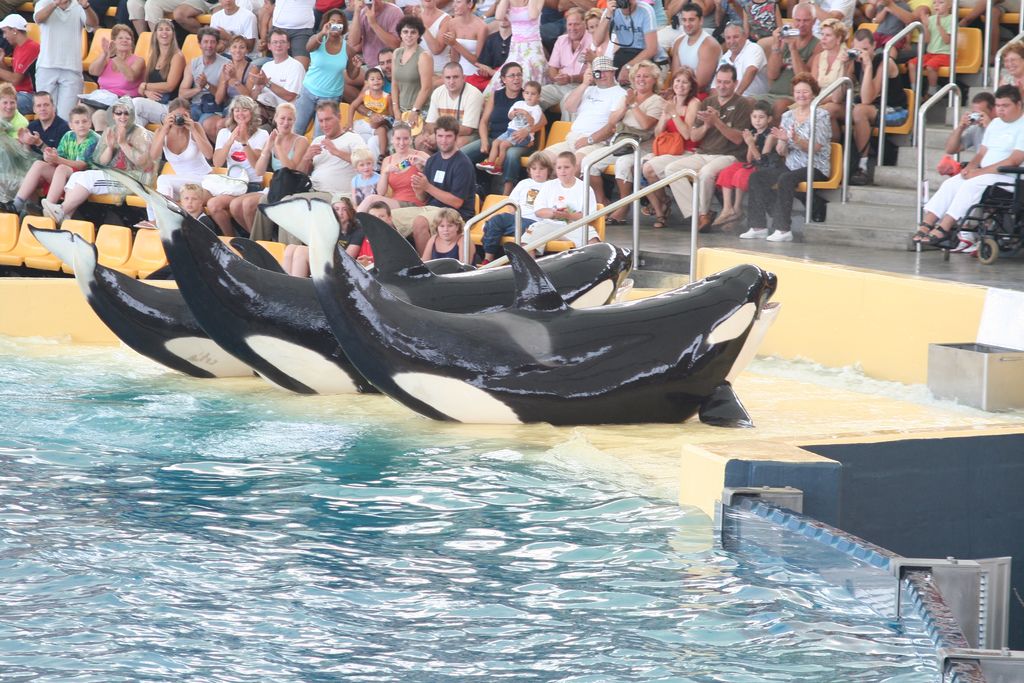 Check the best accommodation options in Puerto de la Cruz!
Check the best accommodation options in Puerto de la Cruz!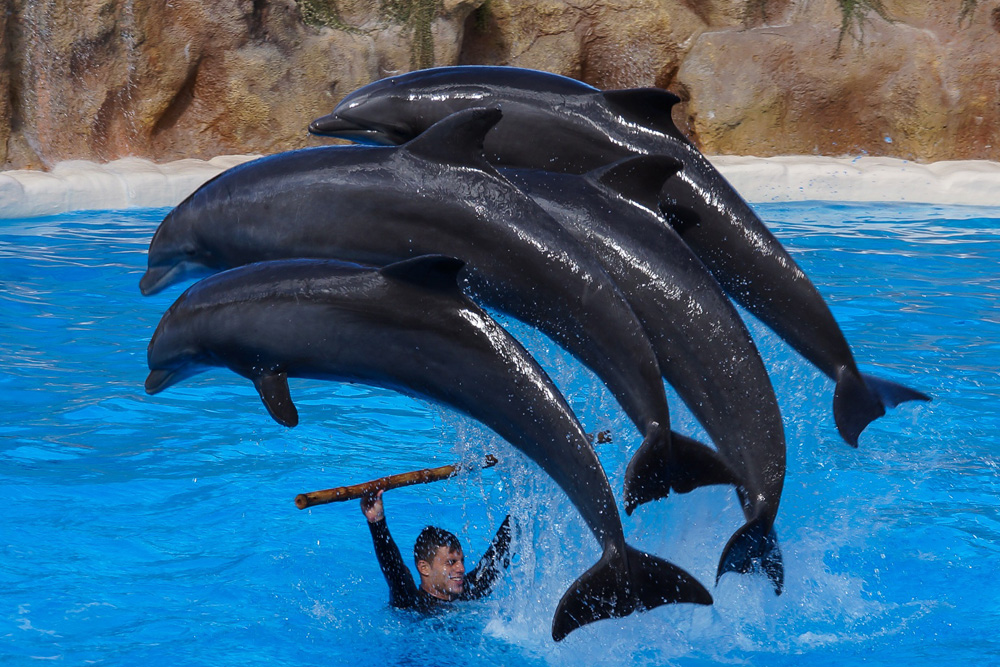 Thank you for supporting our work!
Thank you for supporting our work!